
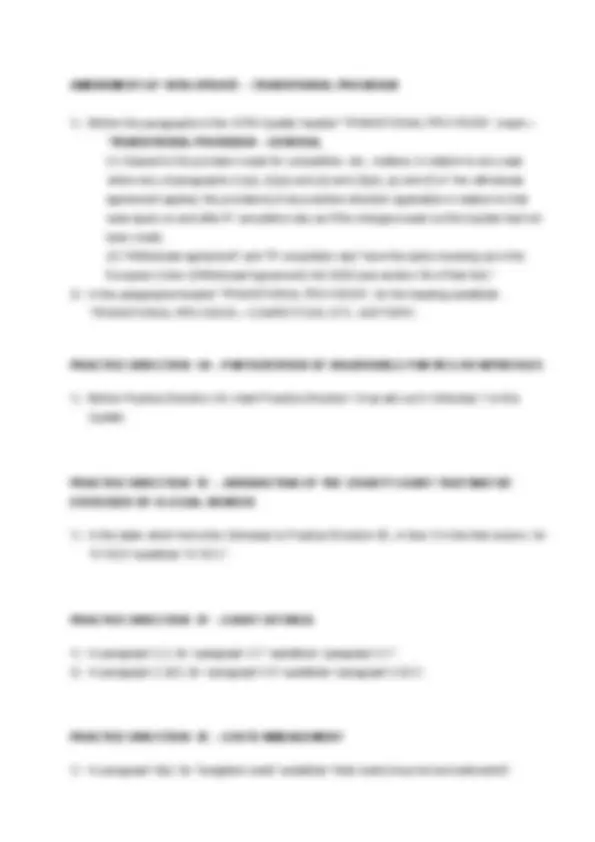
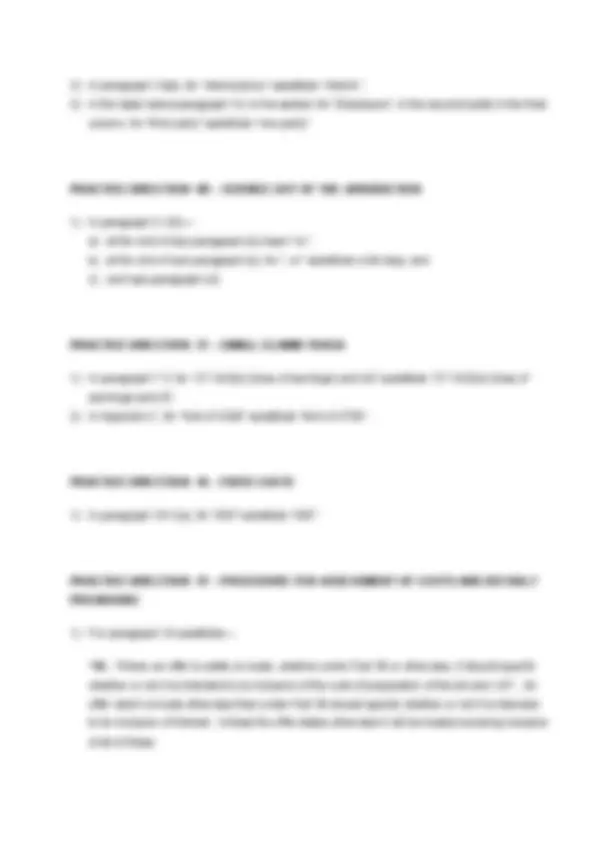
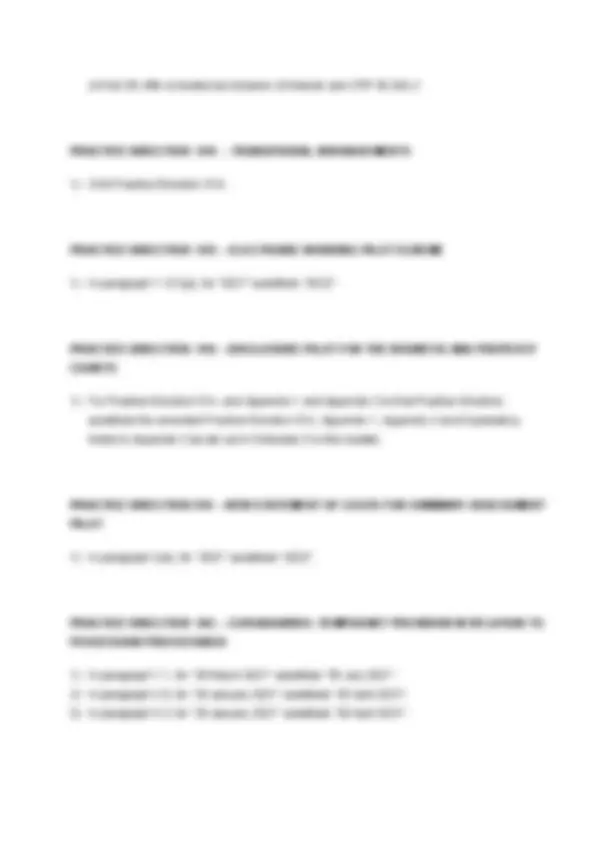
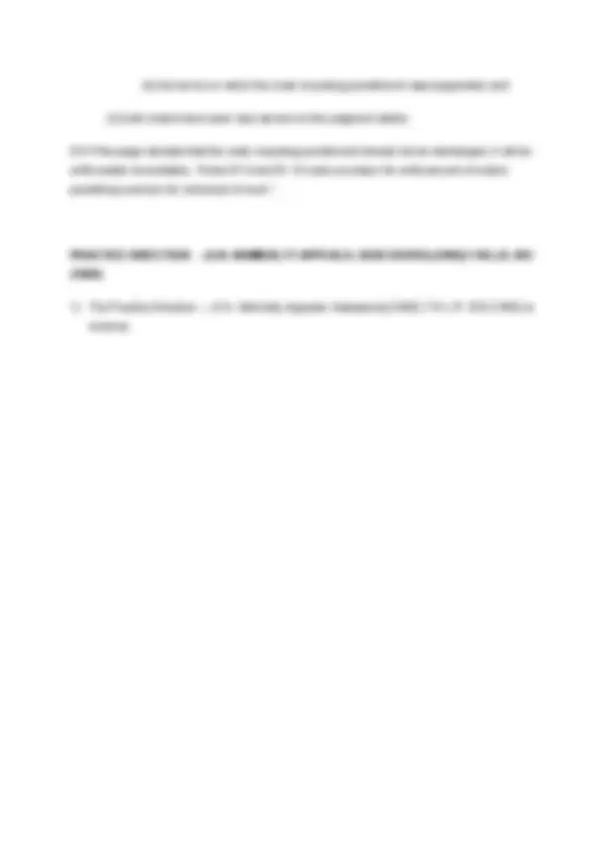
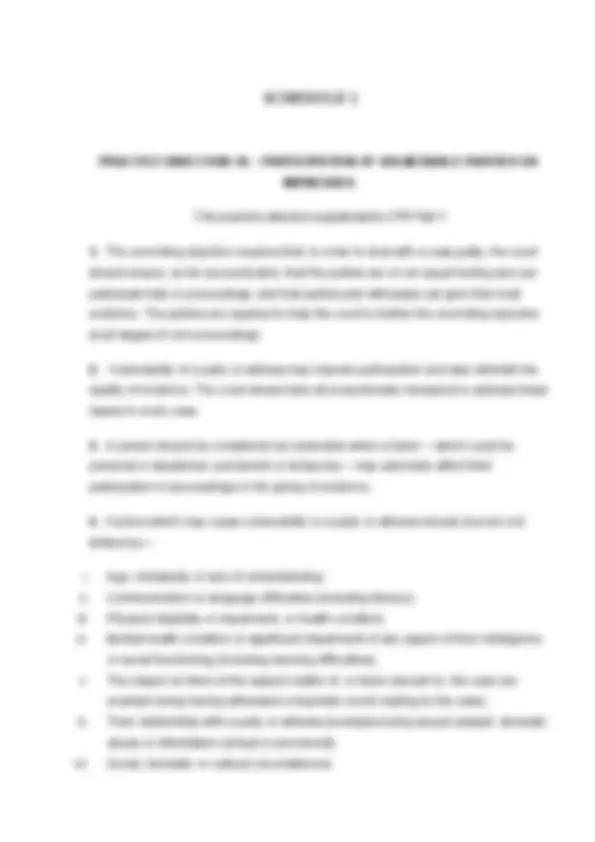
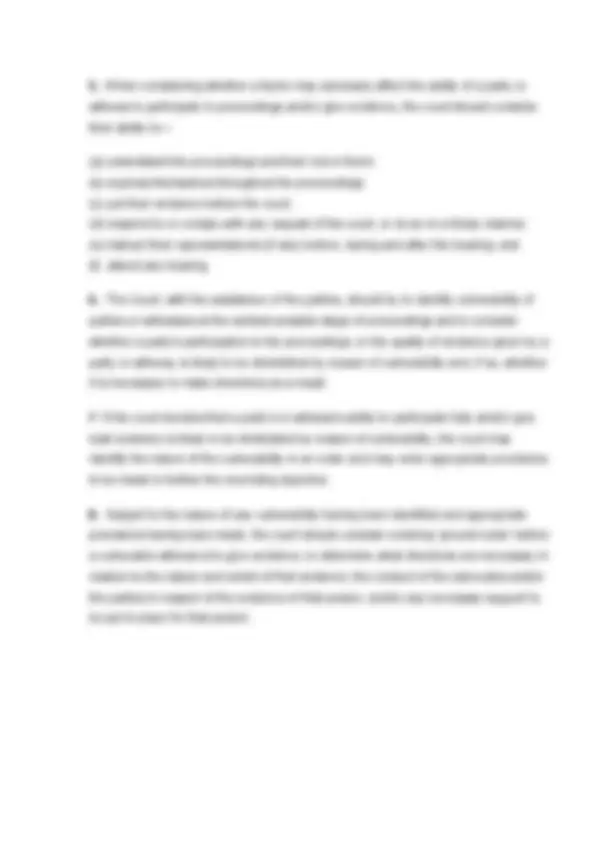
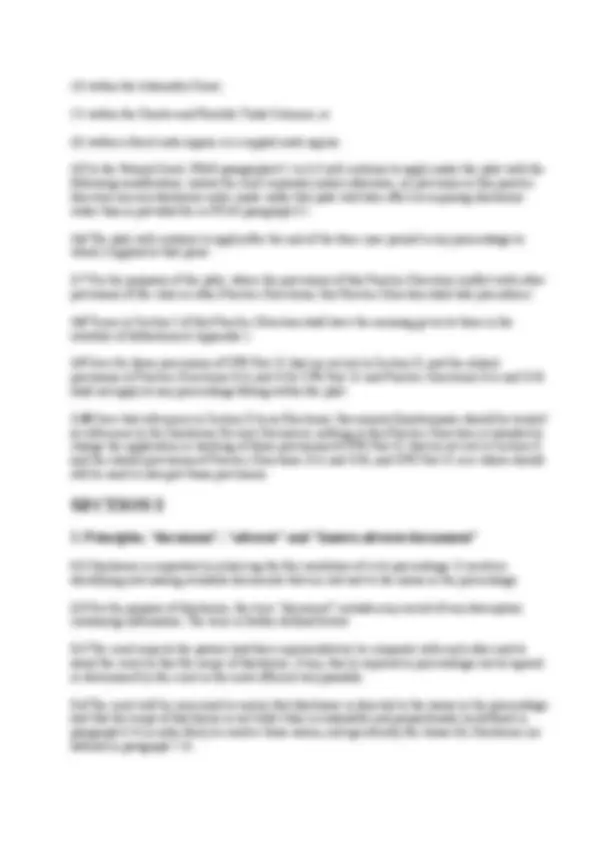
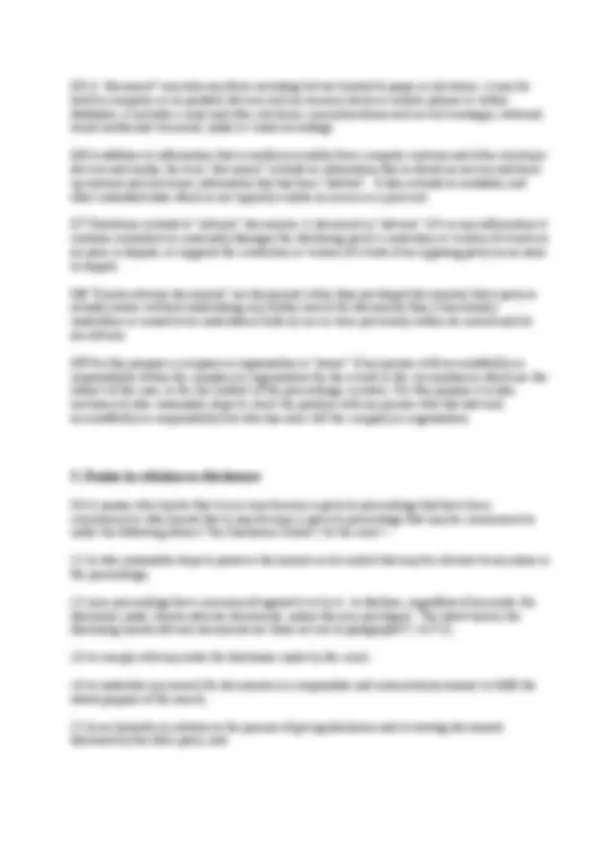
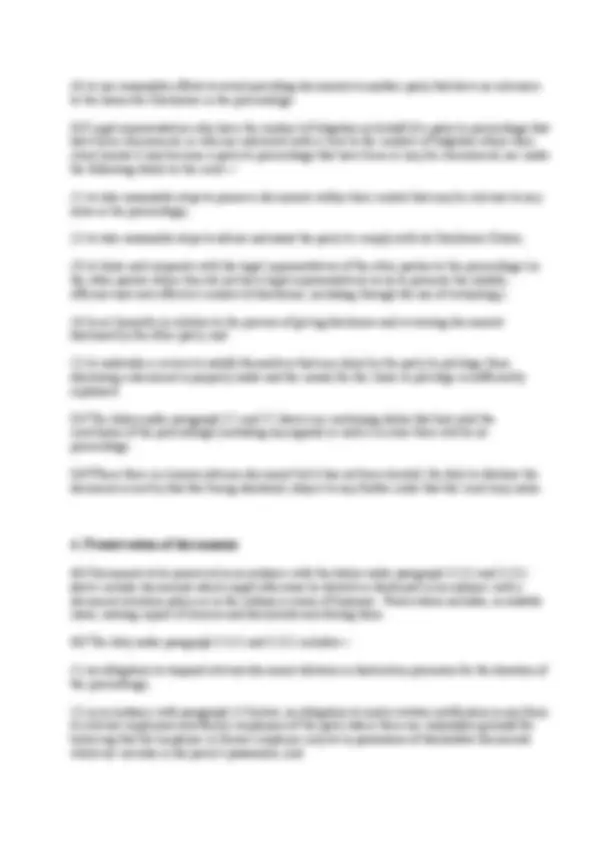
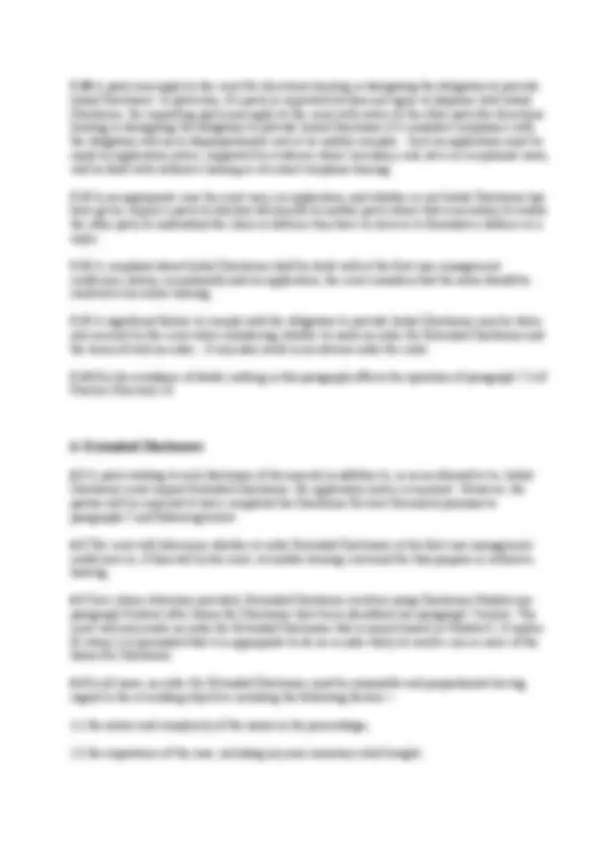
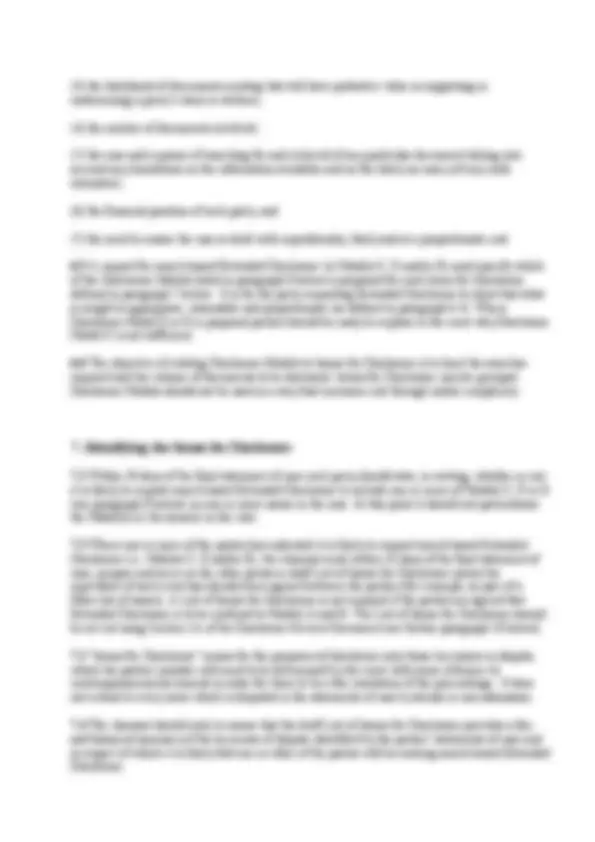
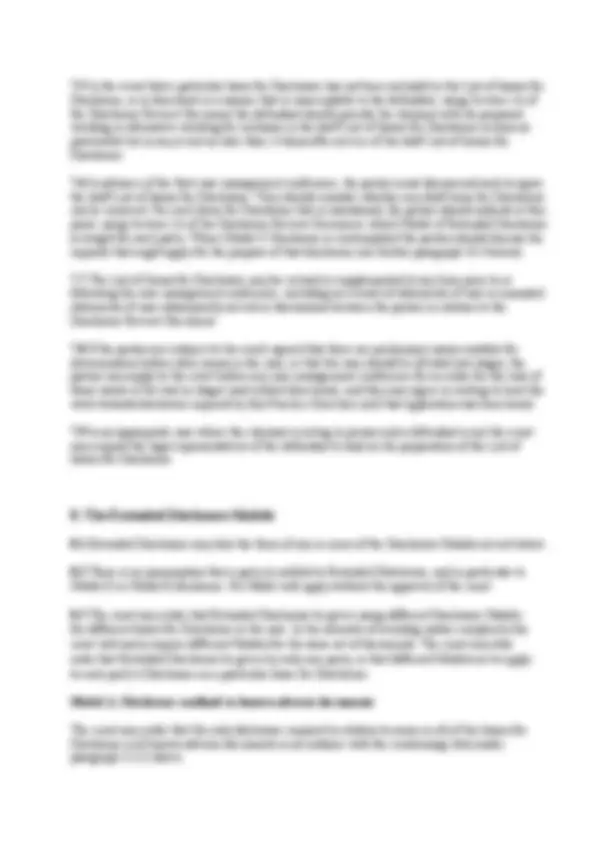
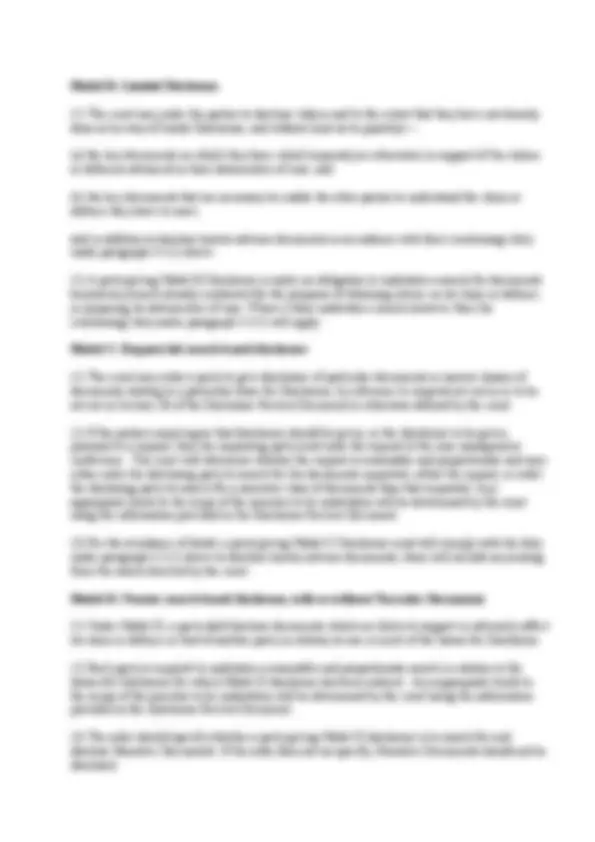
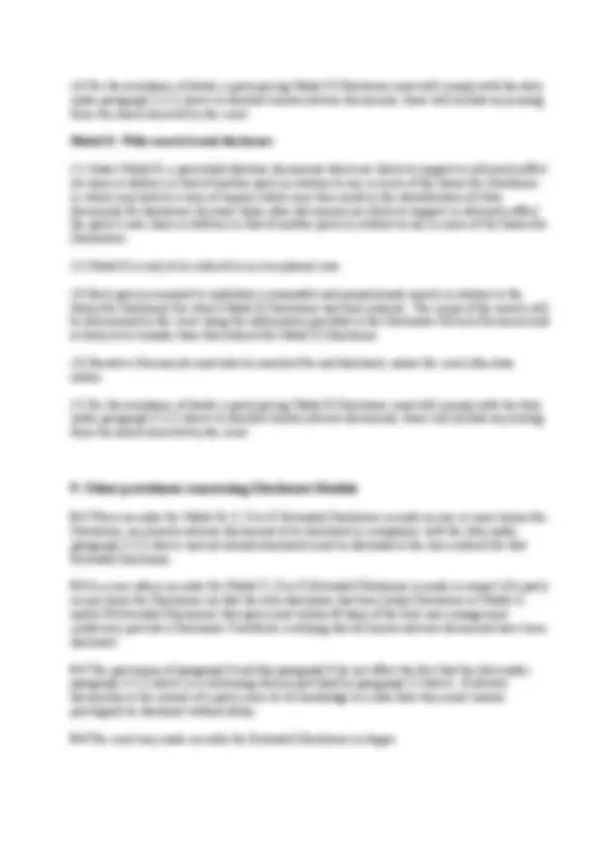
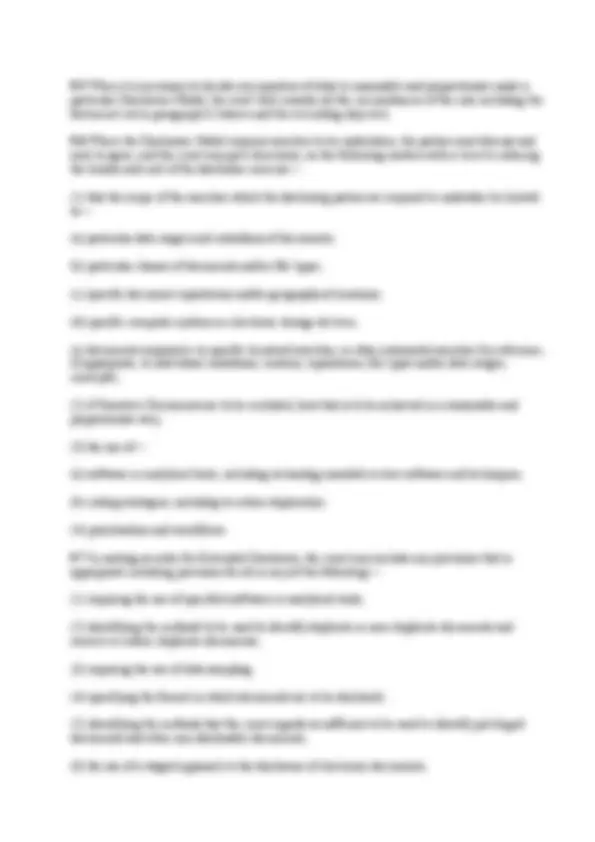
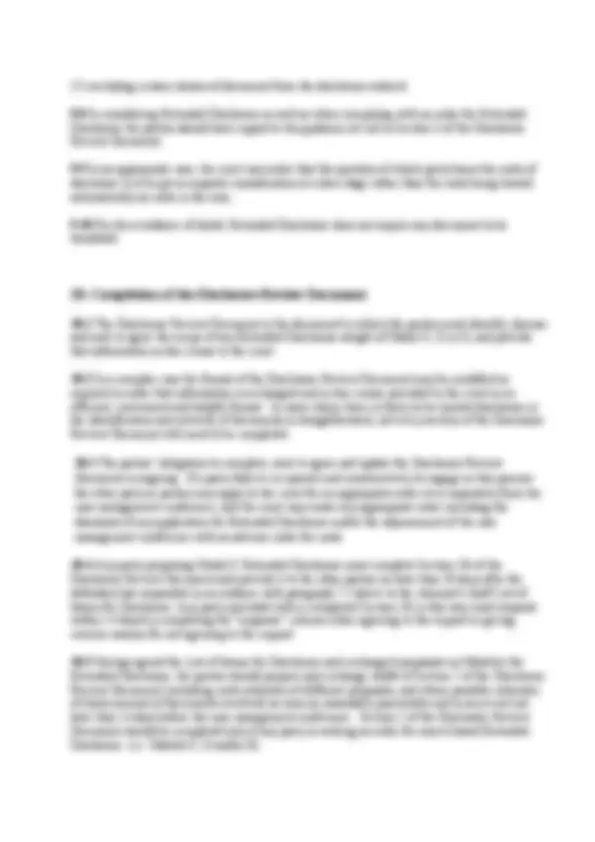
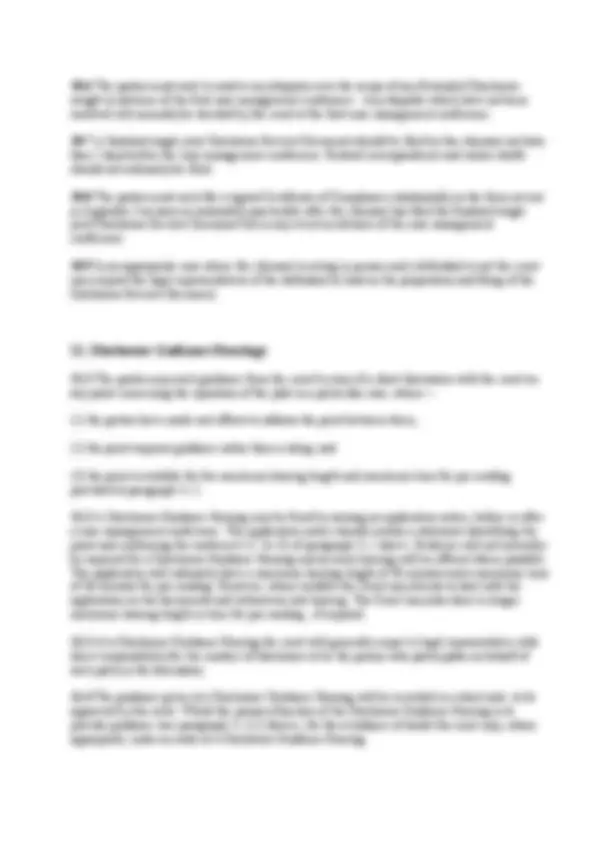
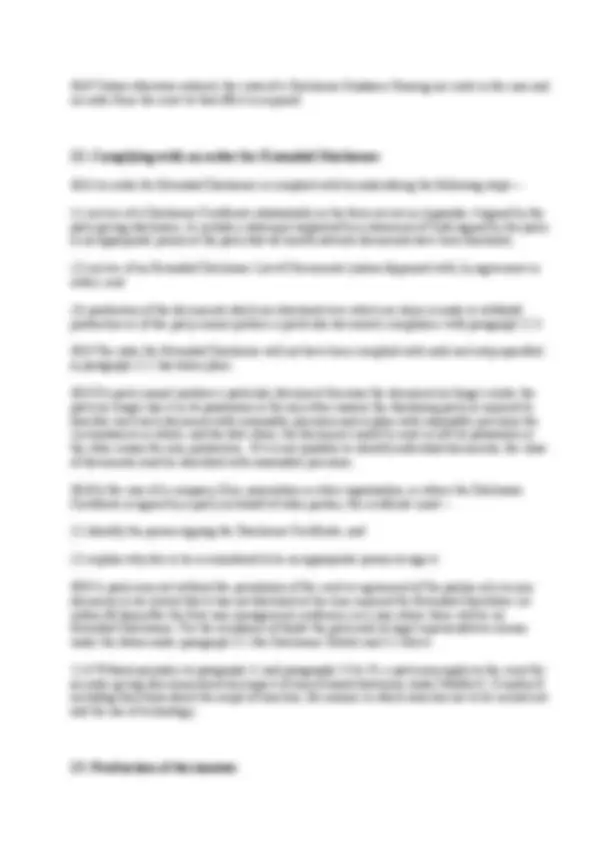
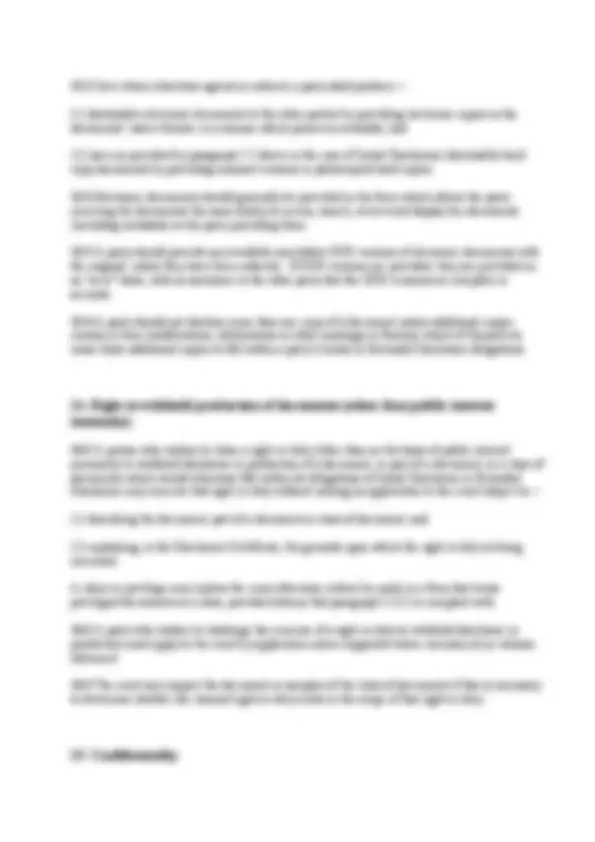
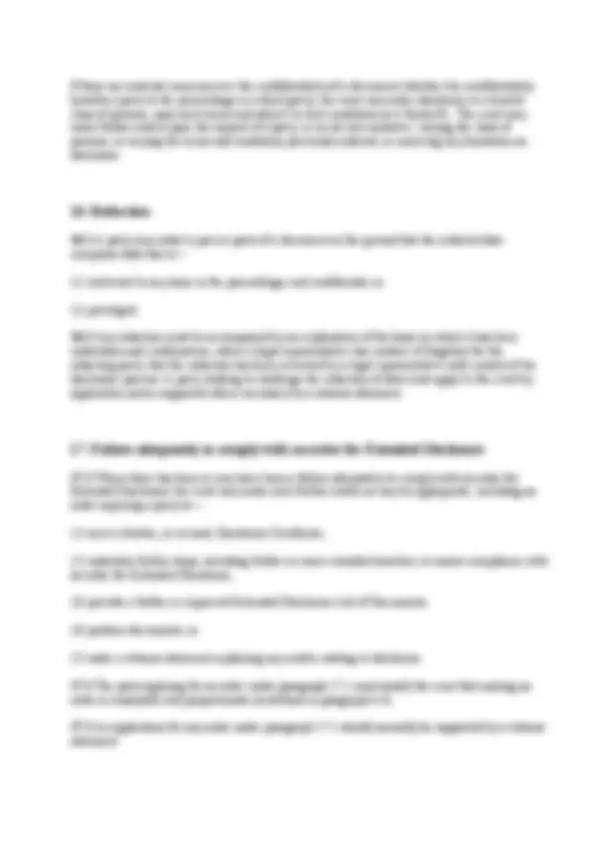
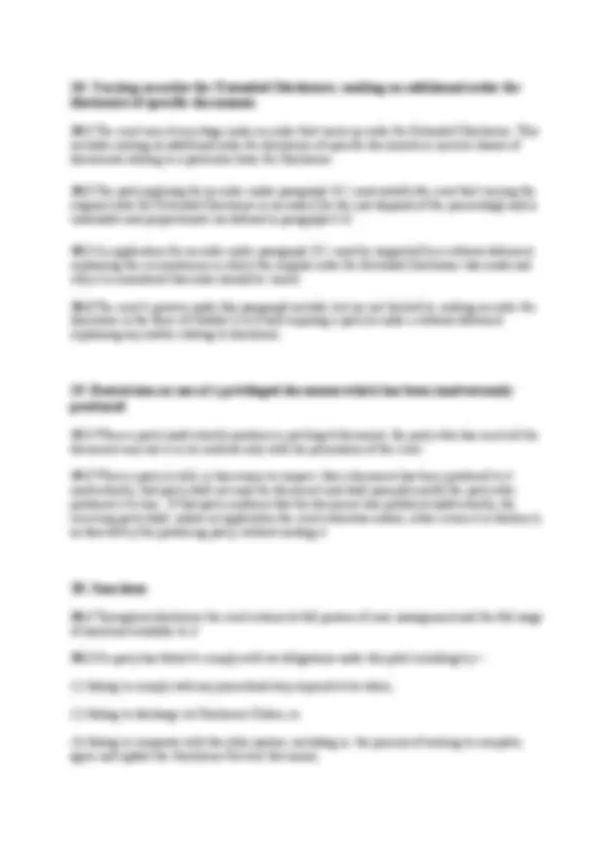
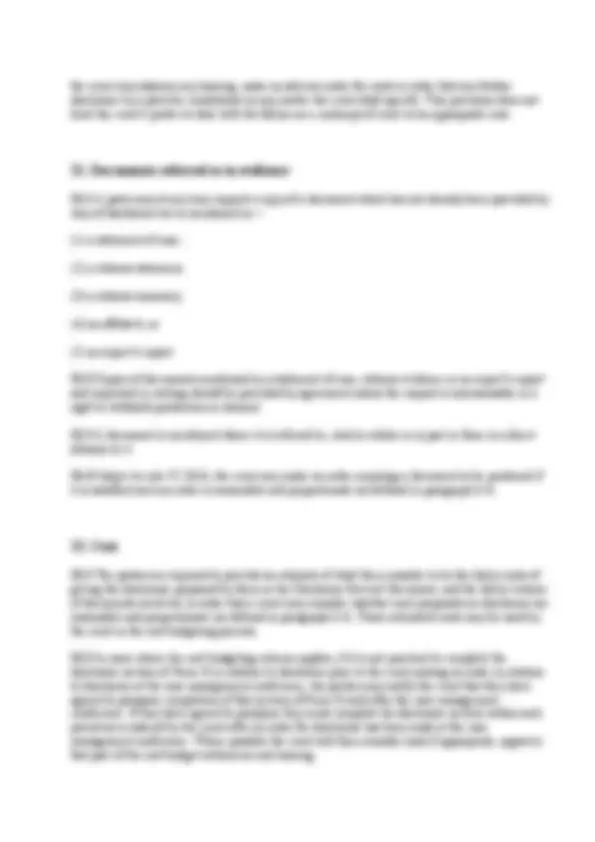
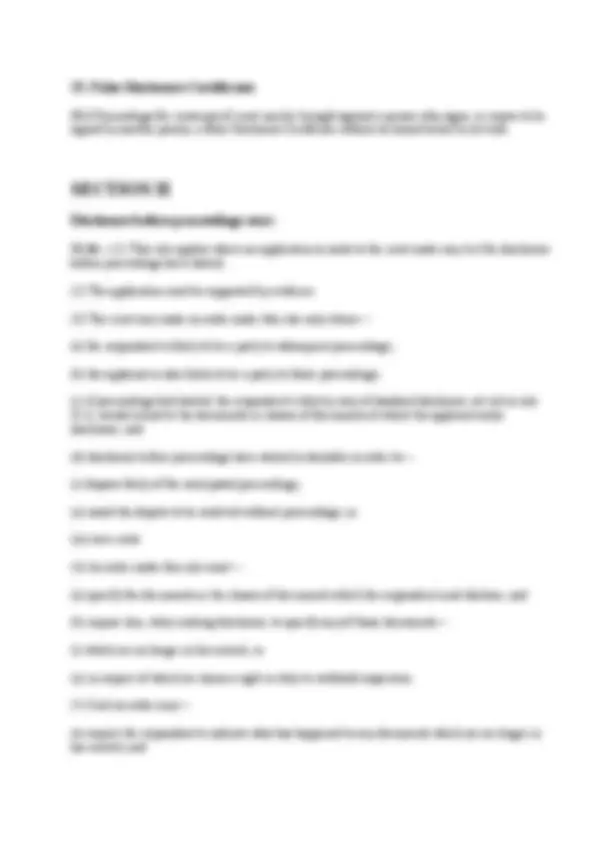
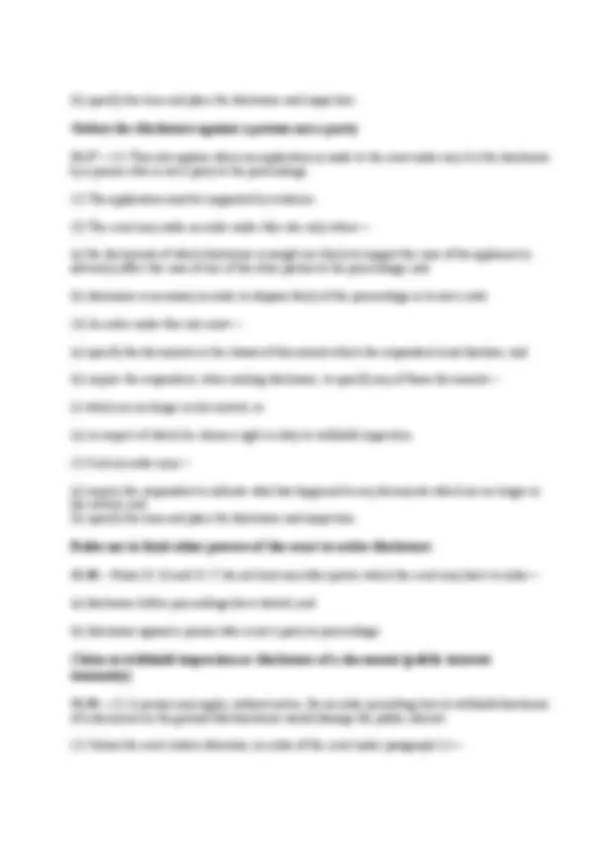

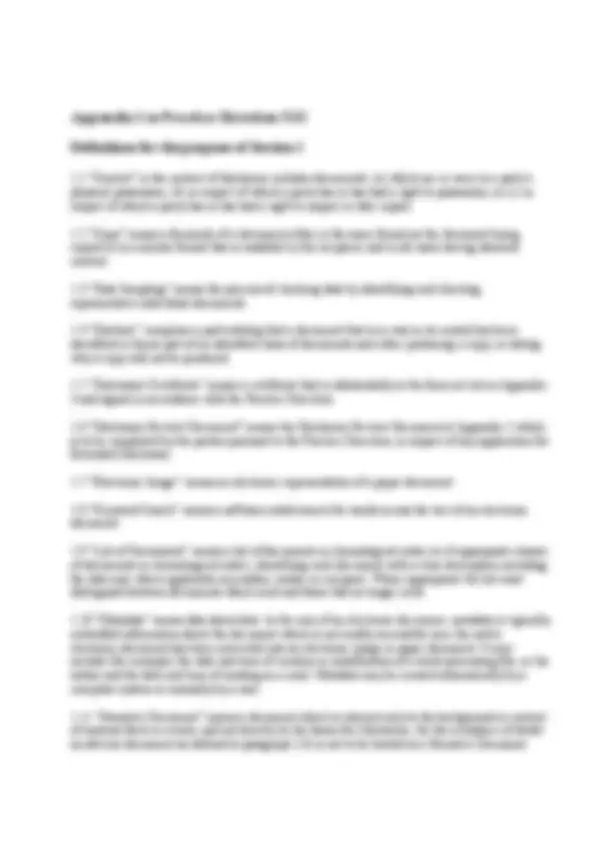

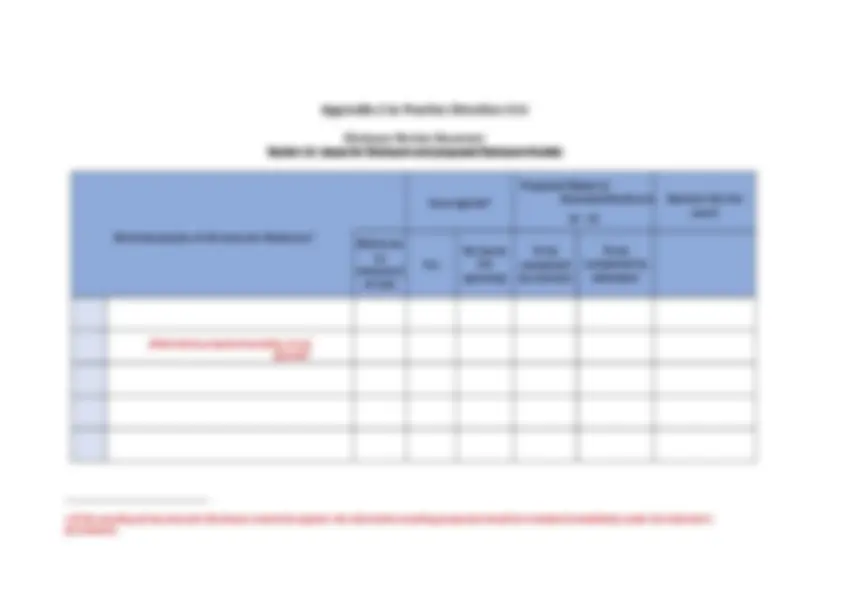
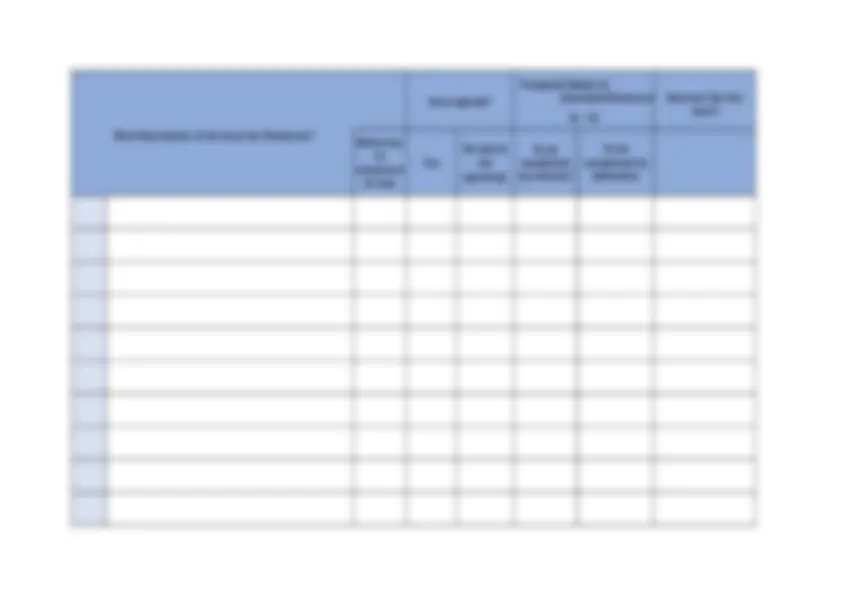
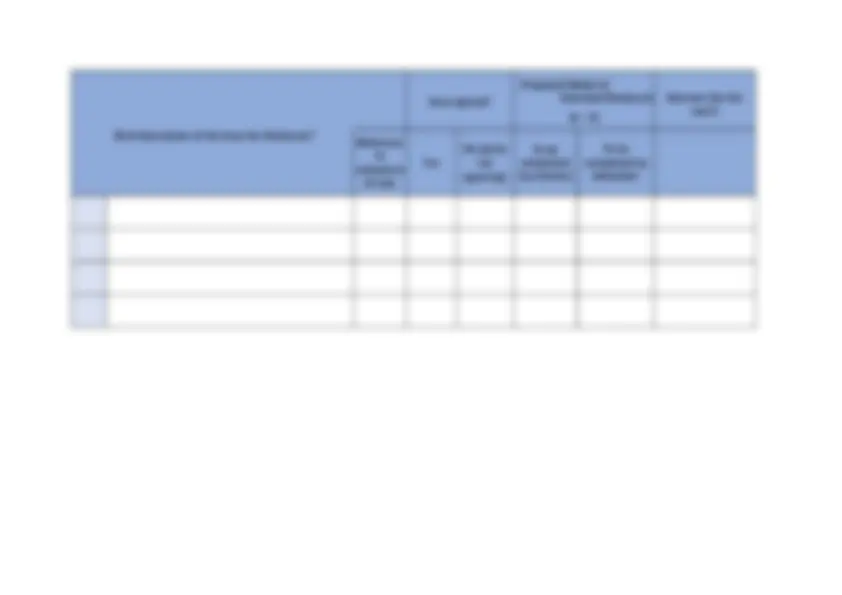

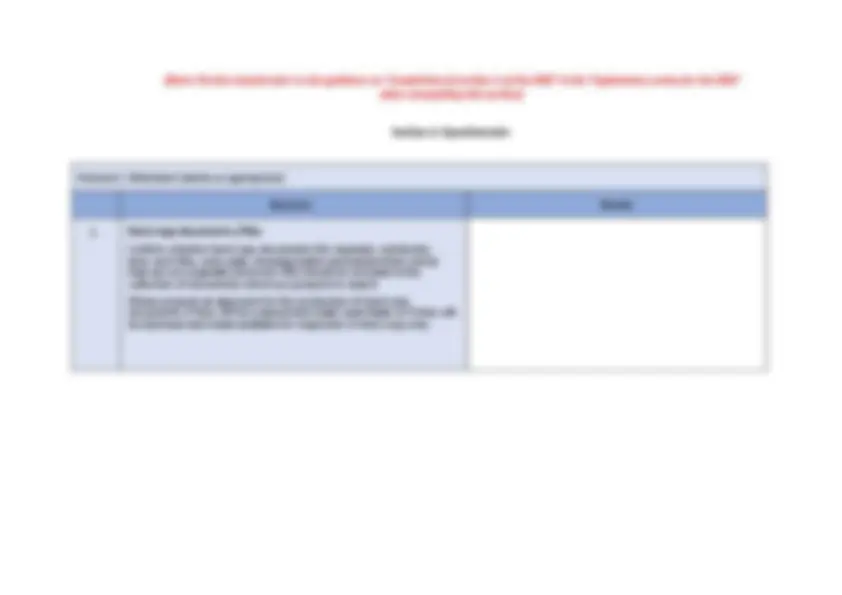
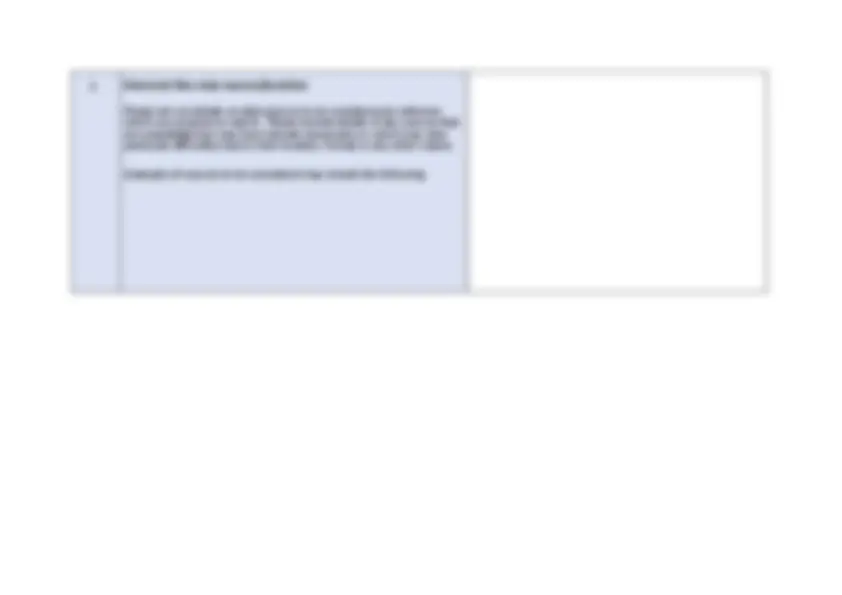
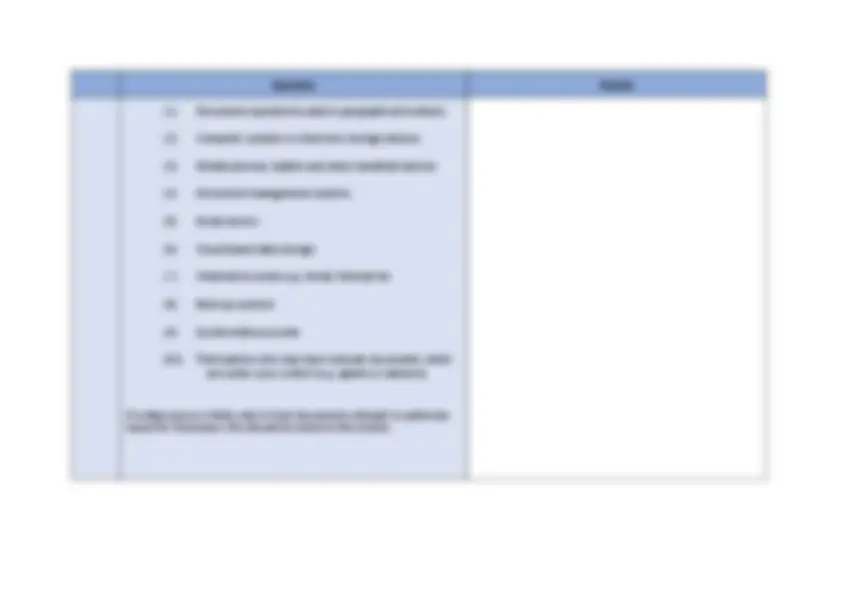

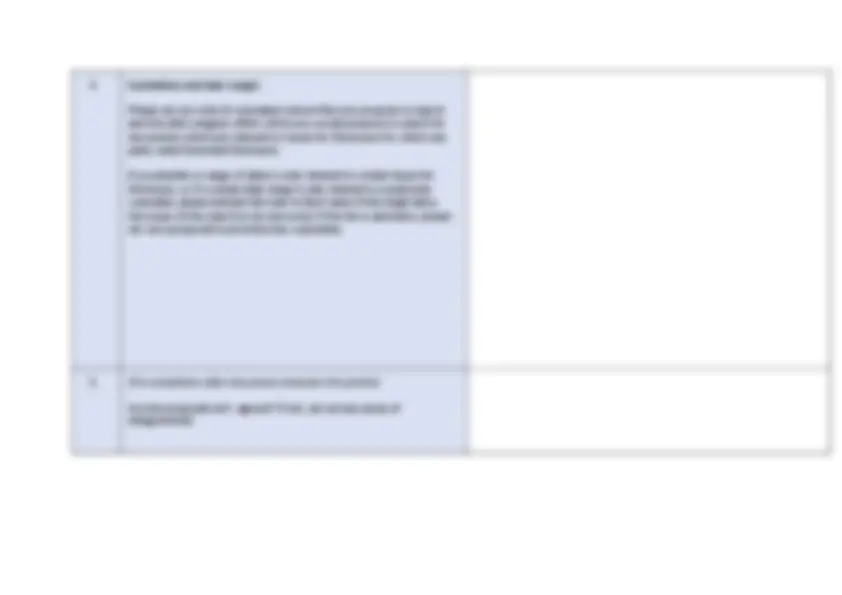
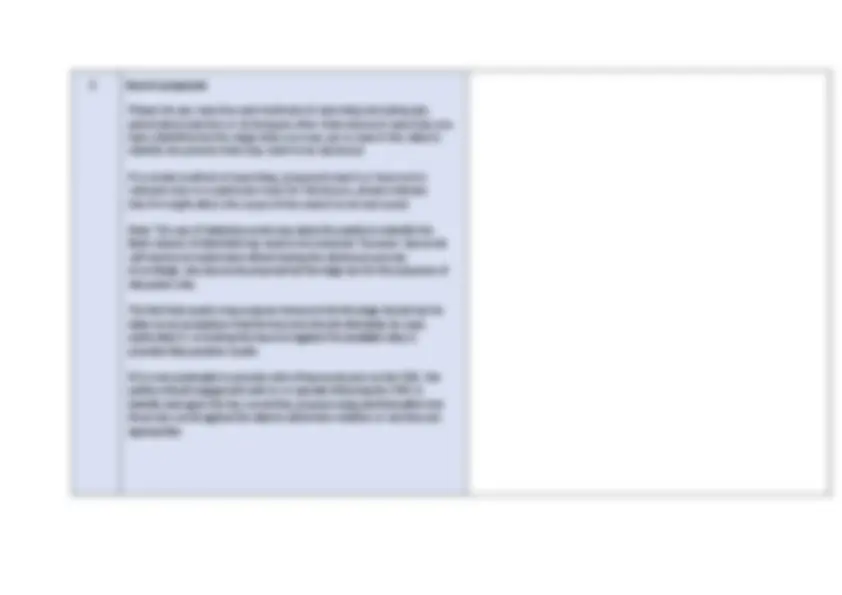
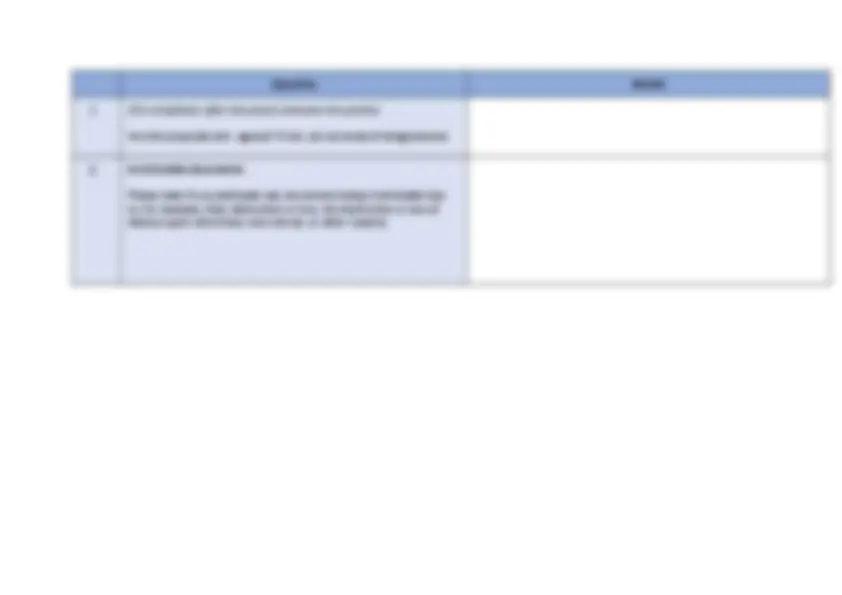
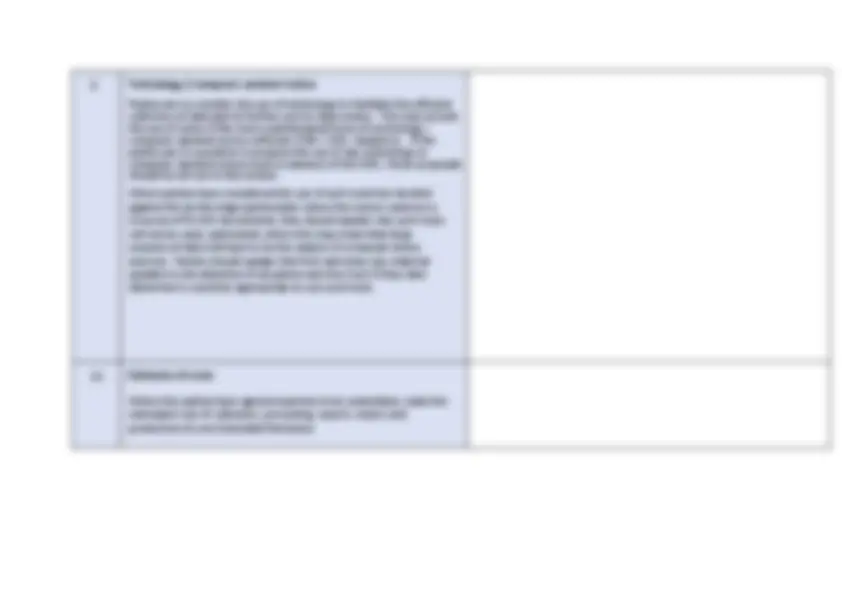
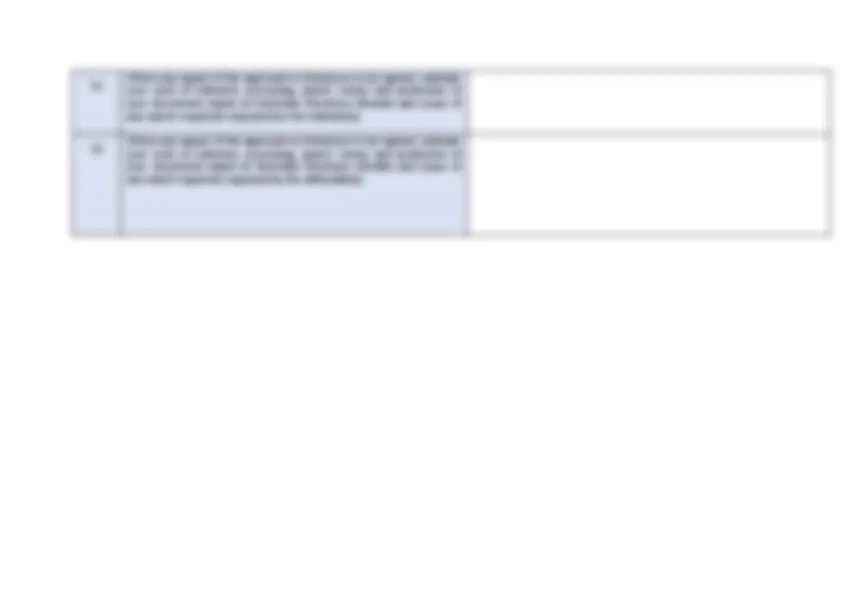
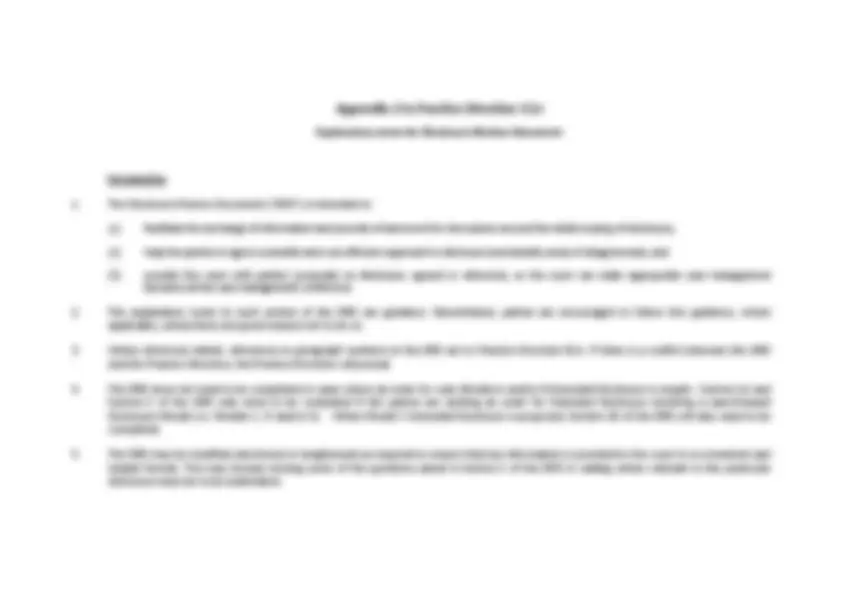
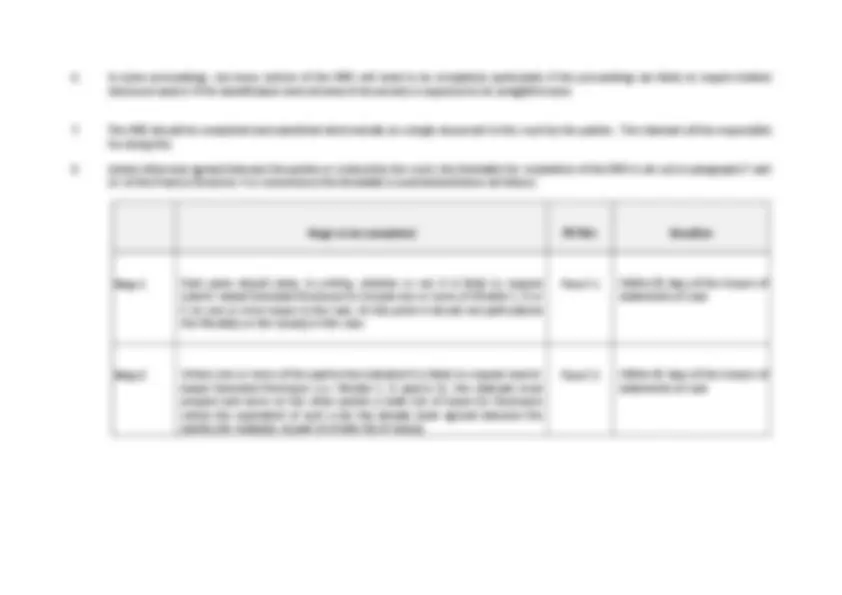

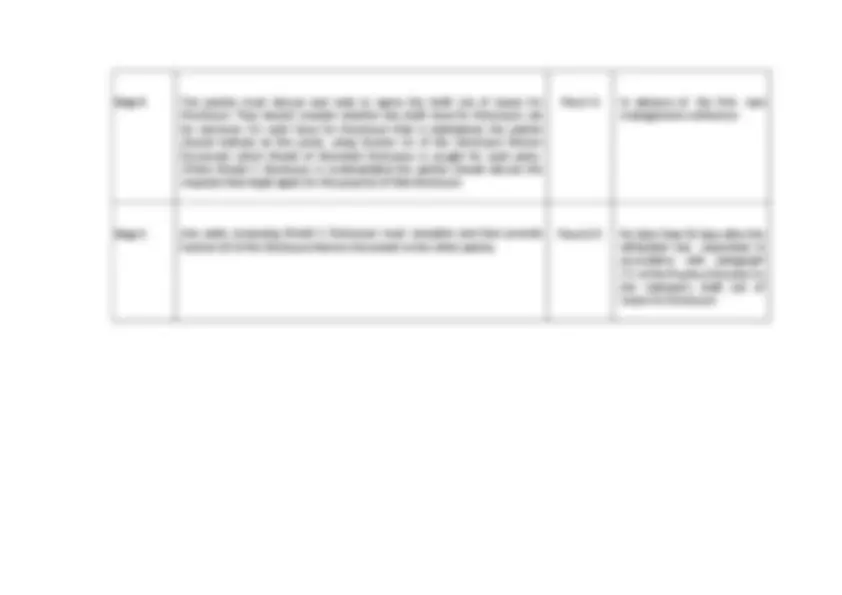
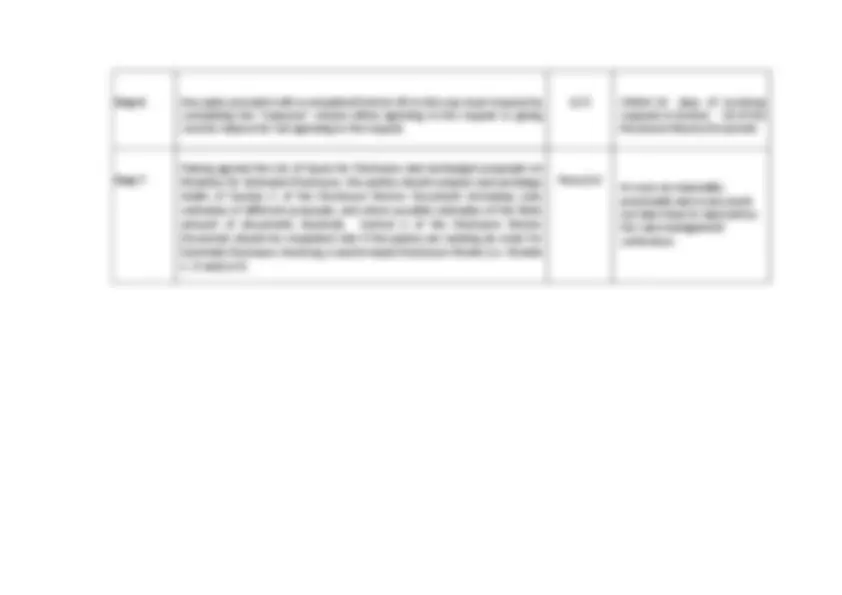
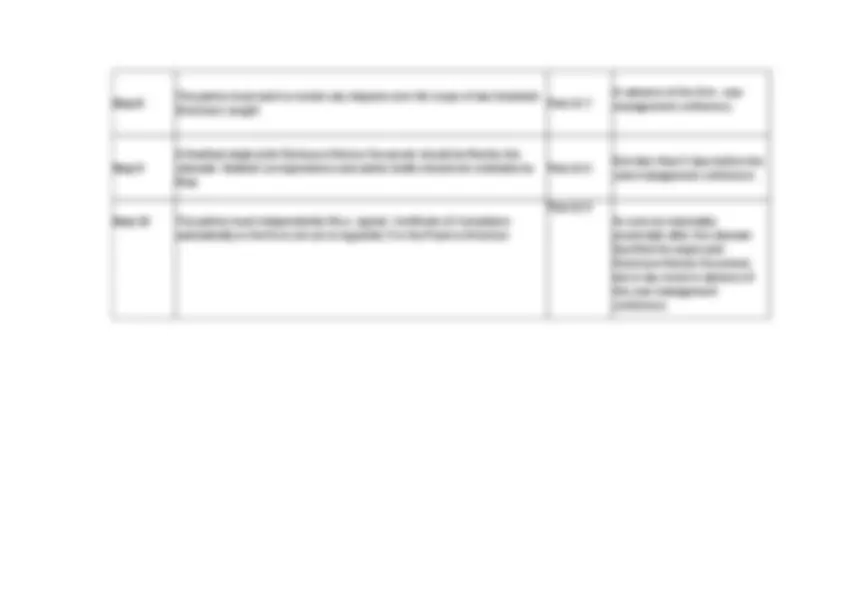
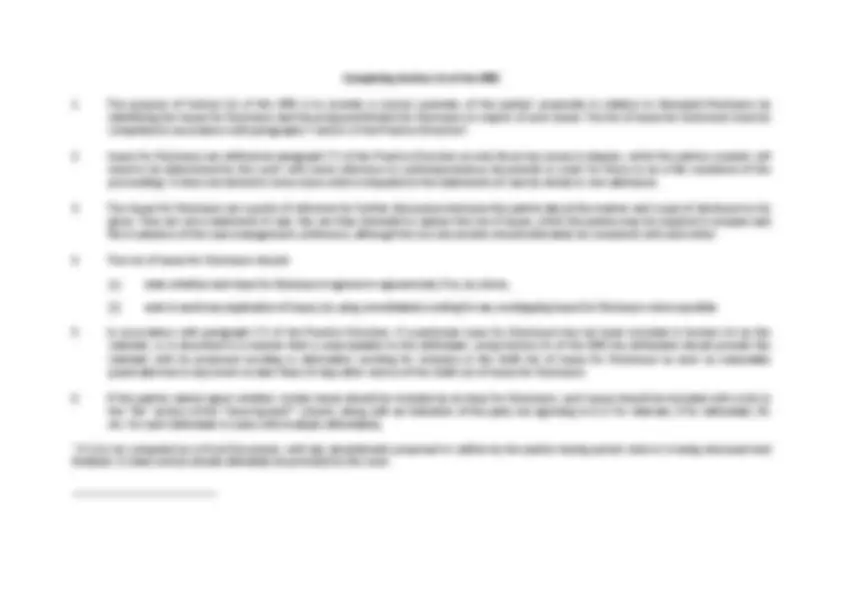
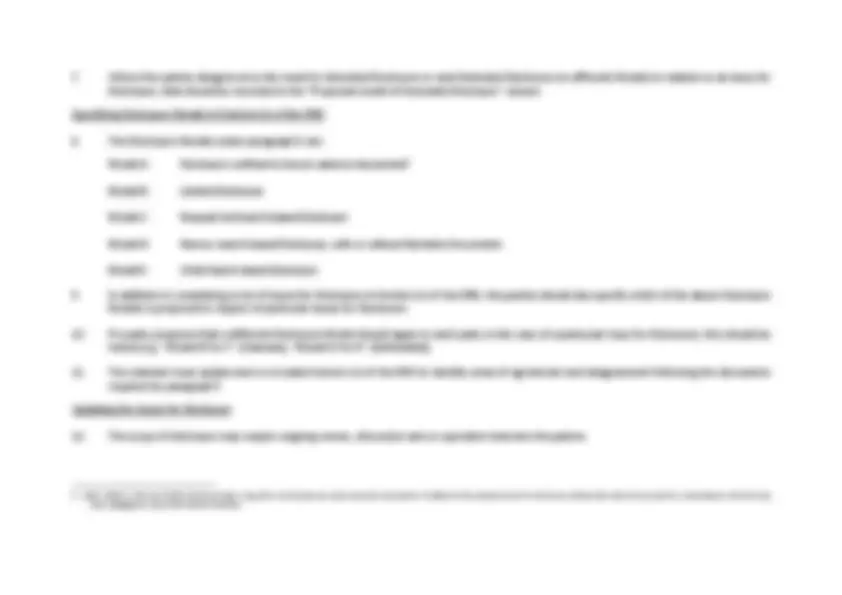
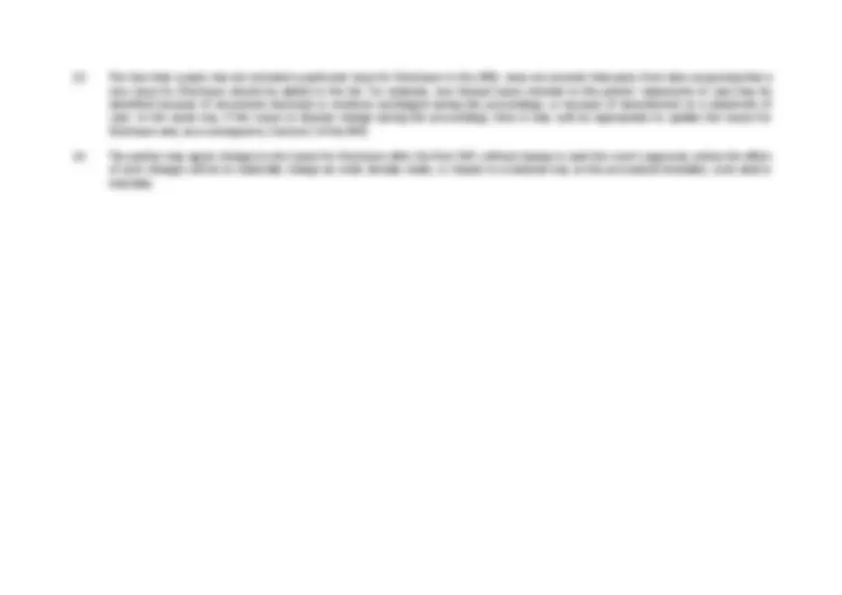
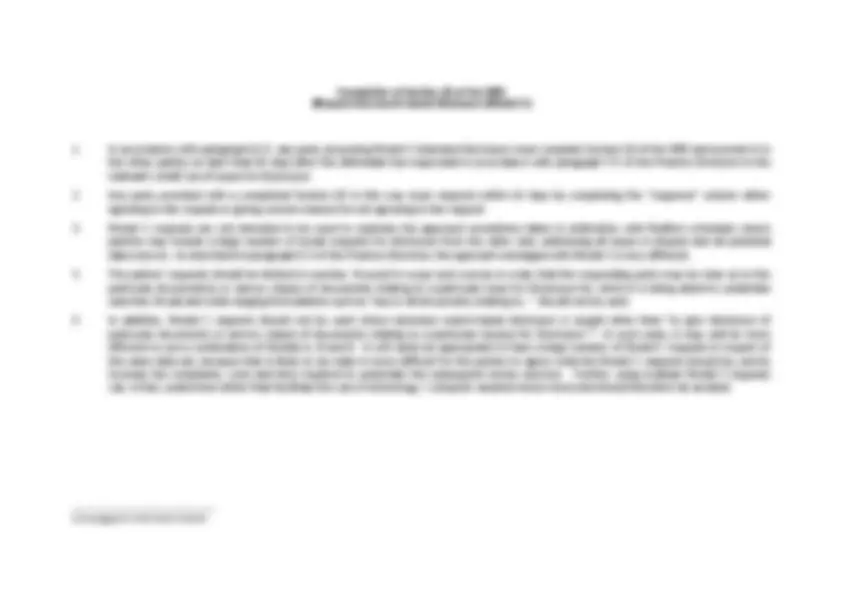
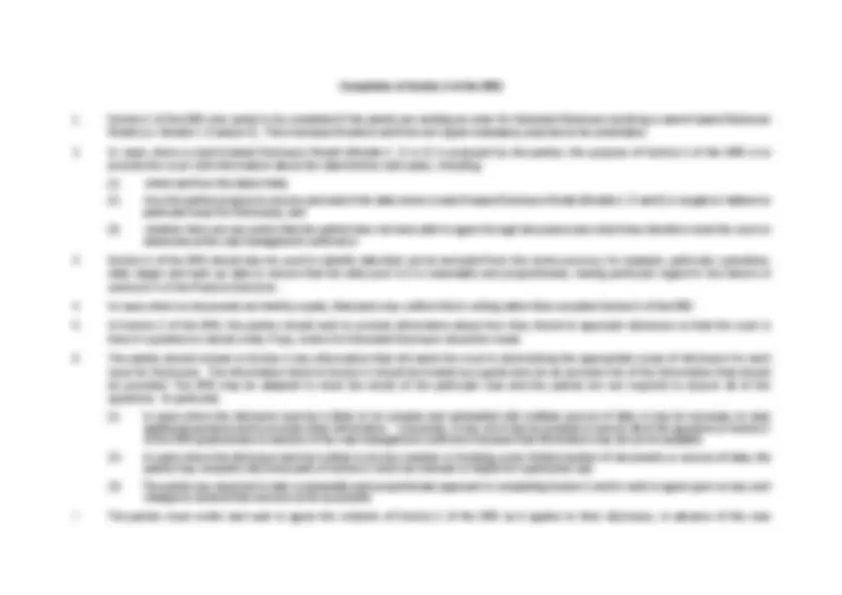
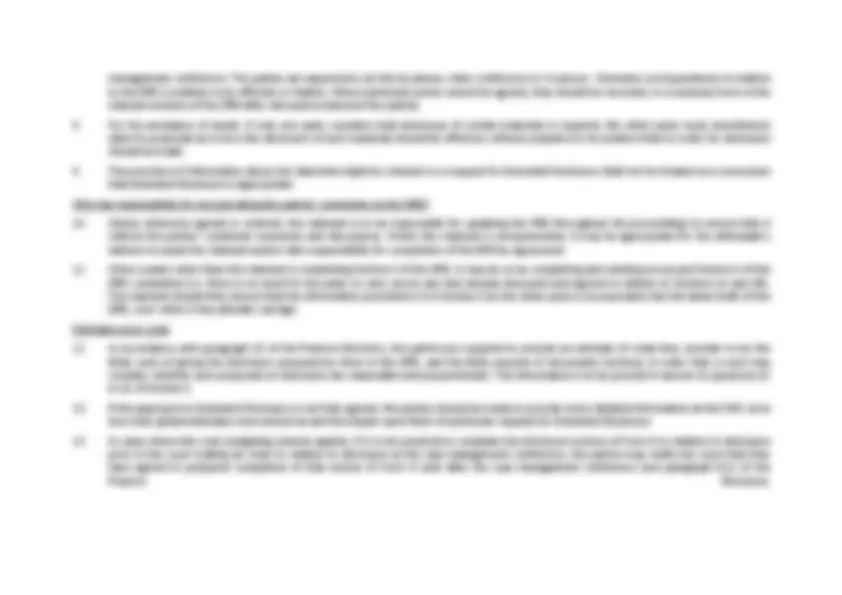
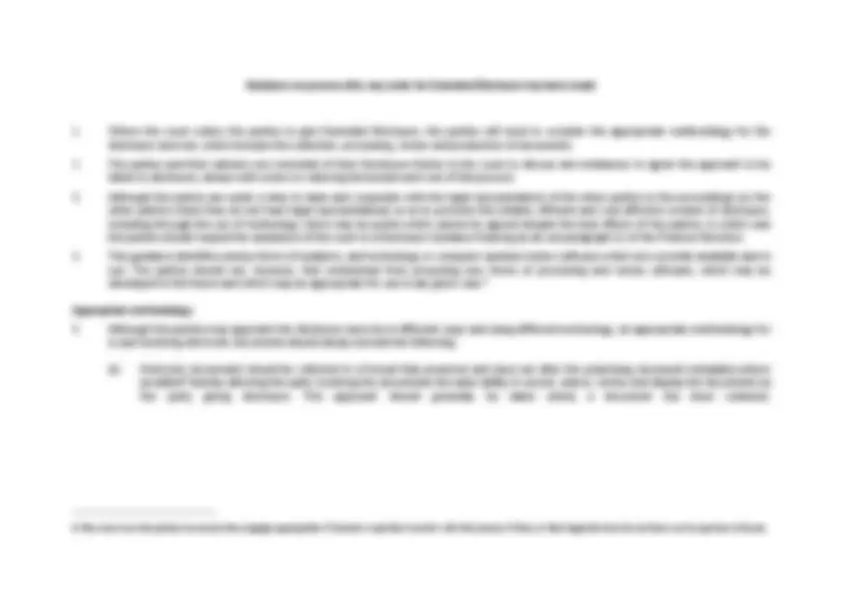
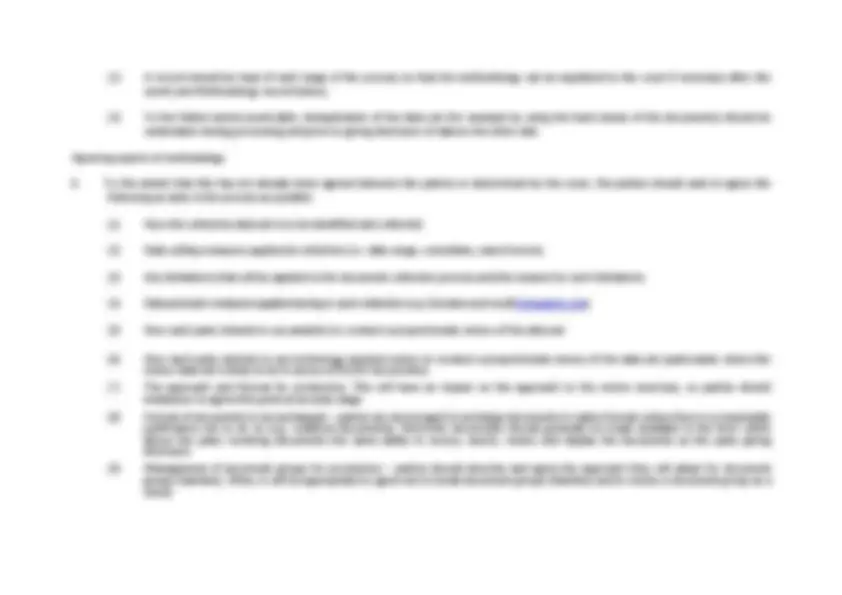
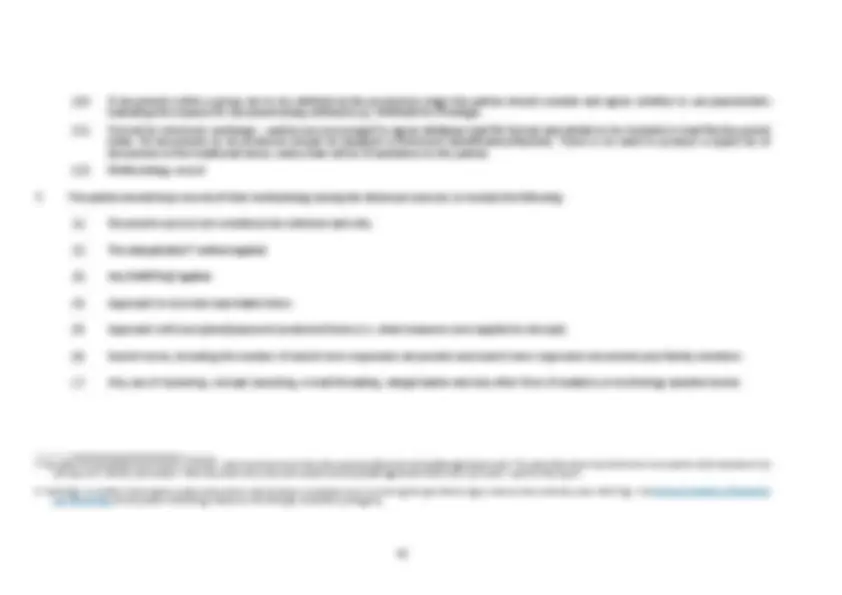
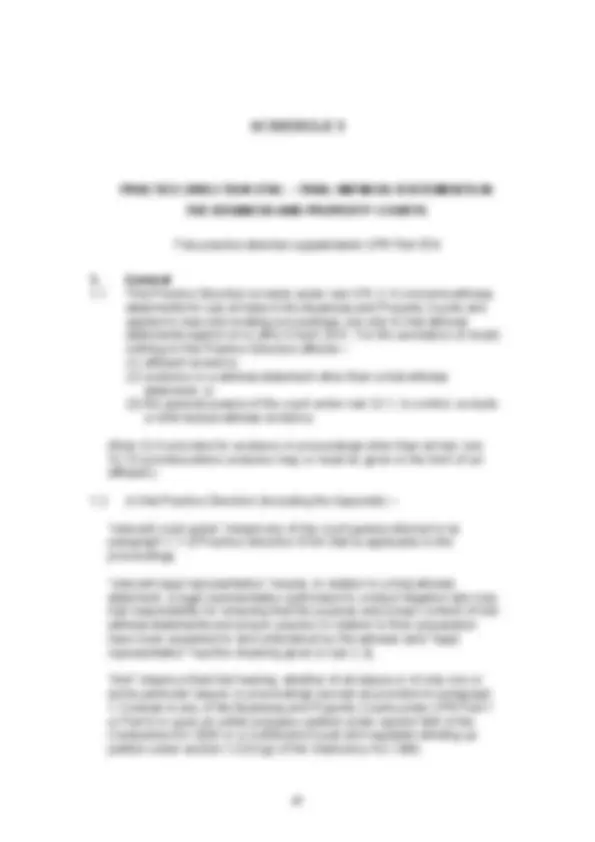
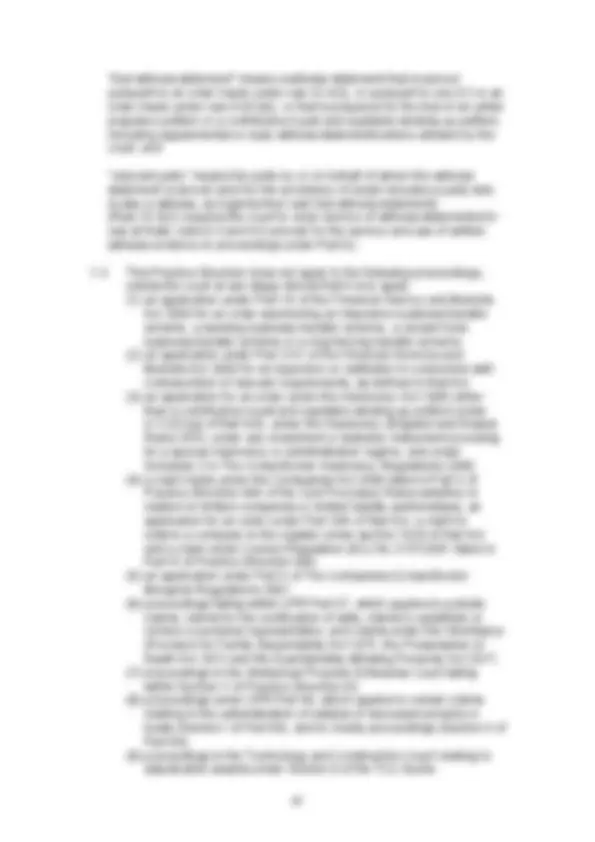
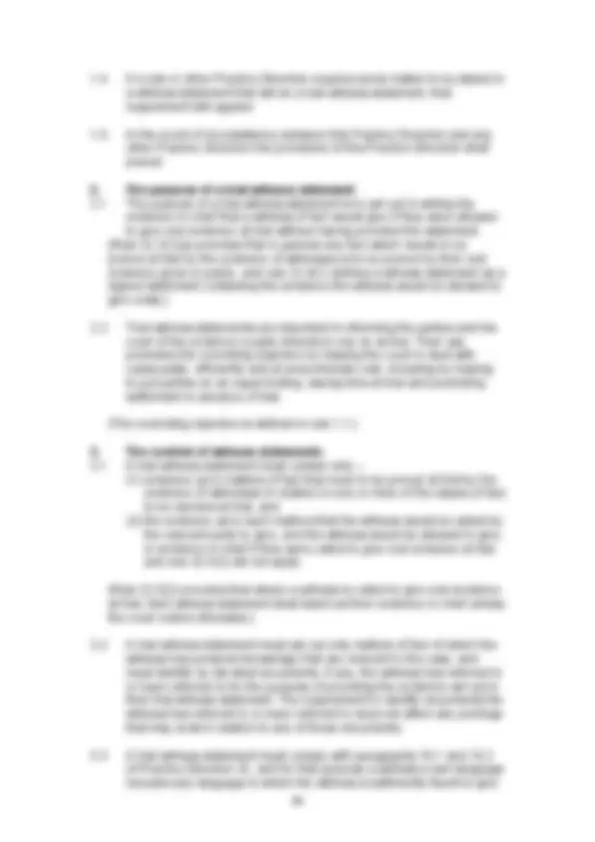
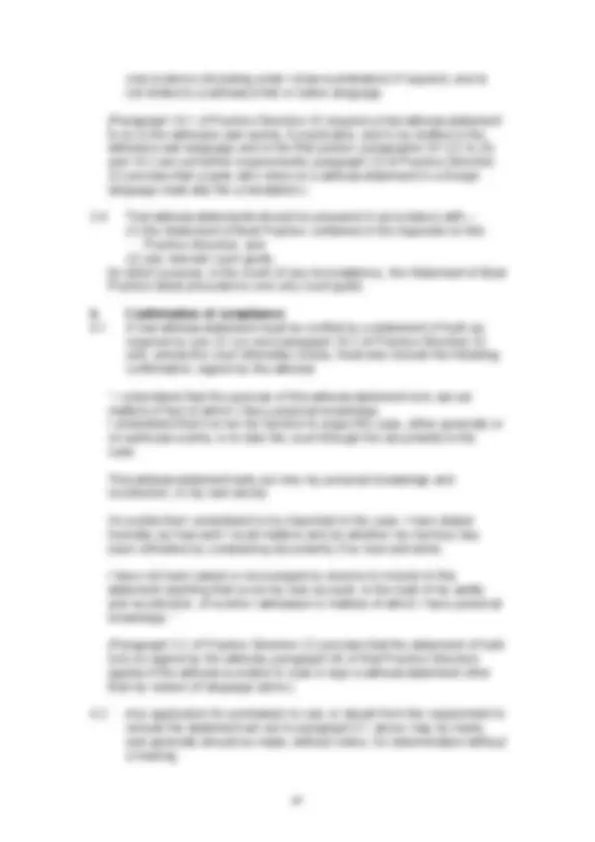
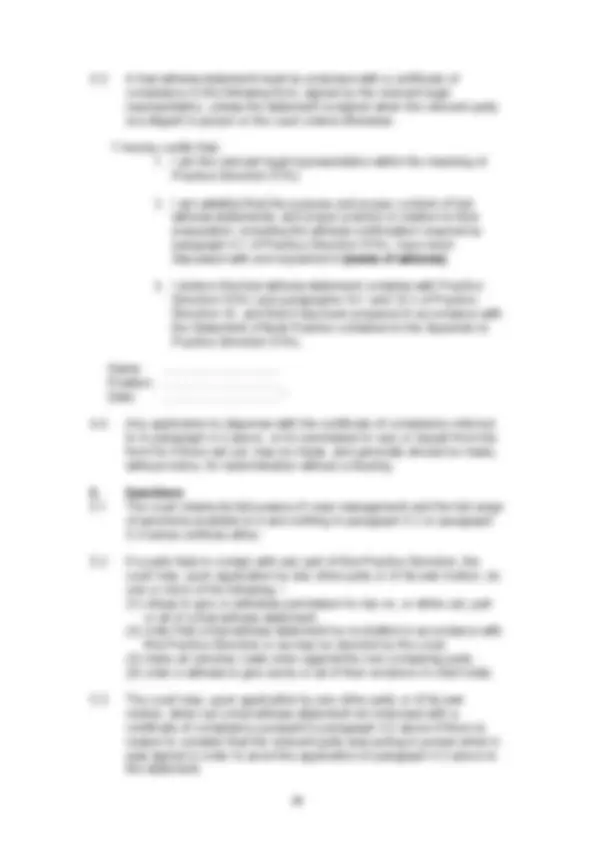
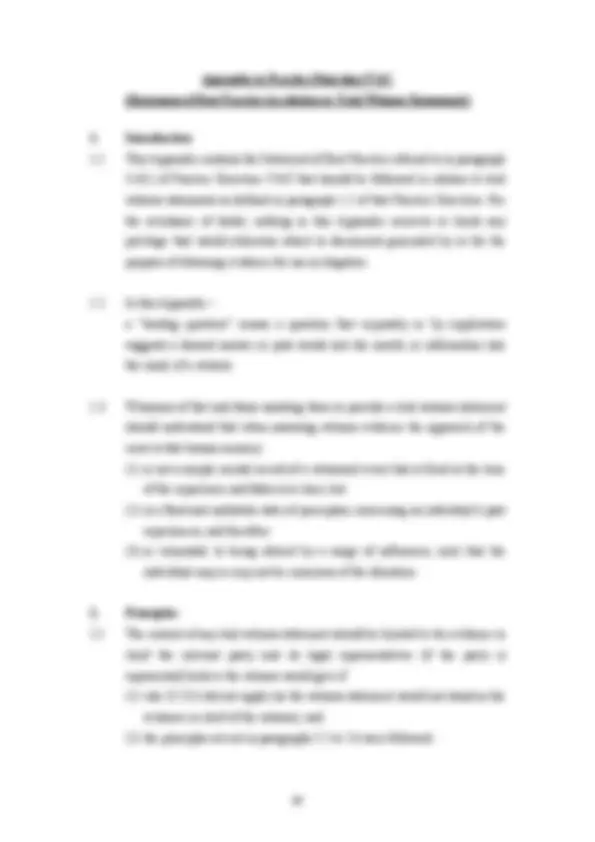
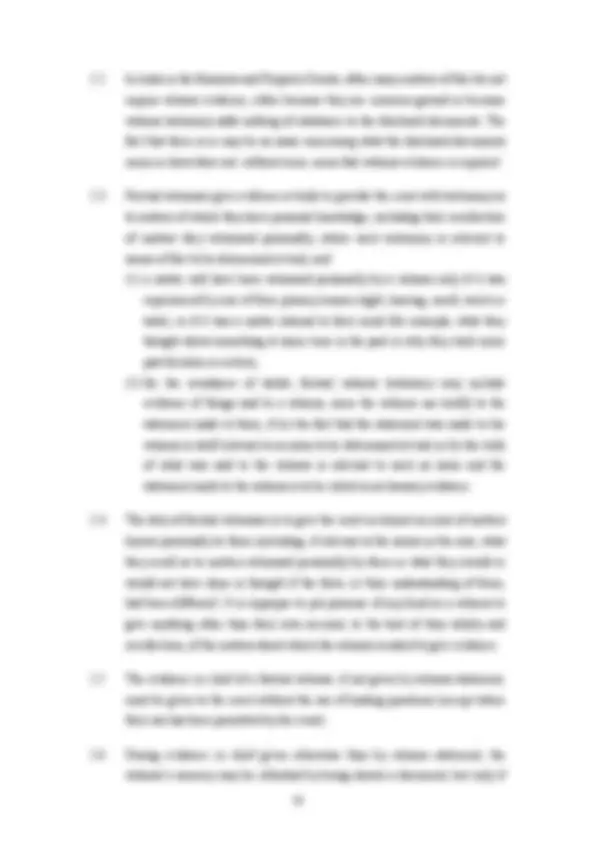
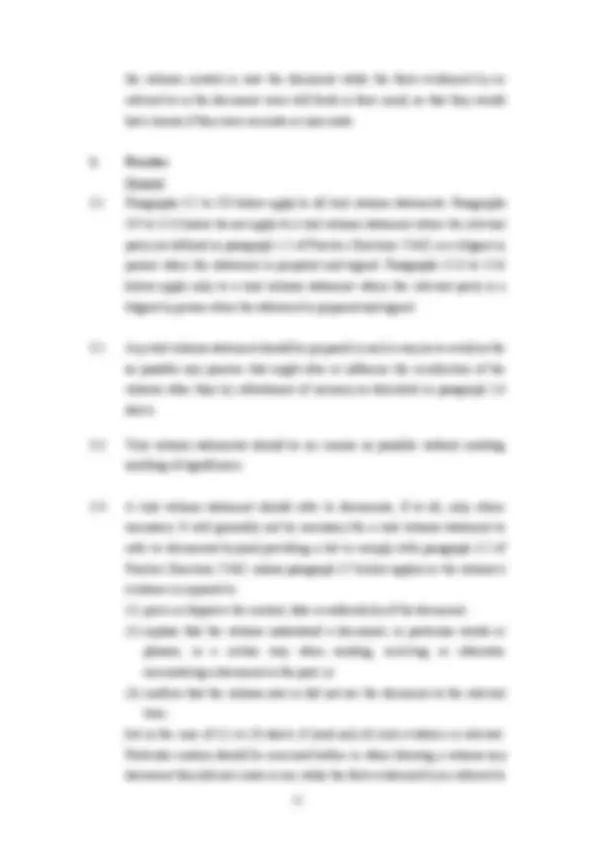
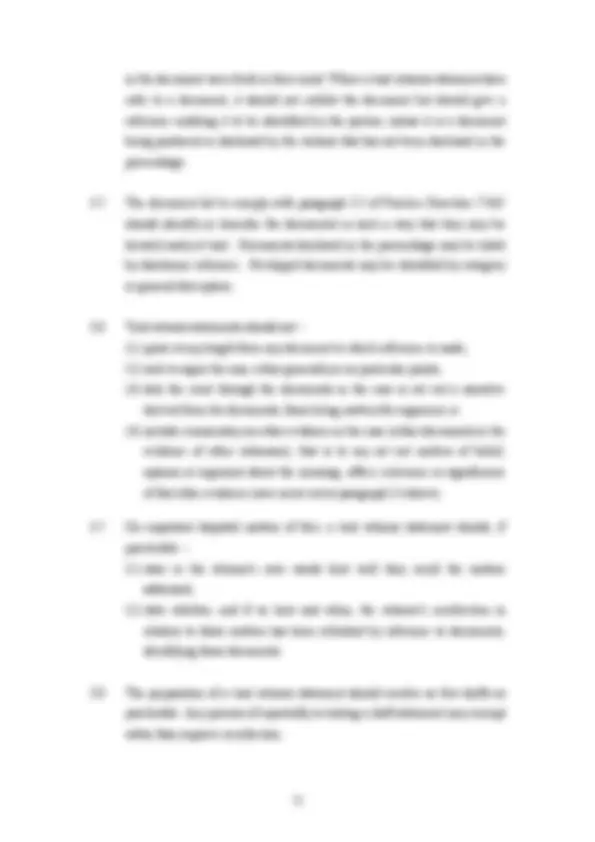
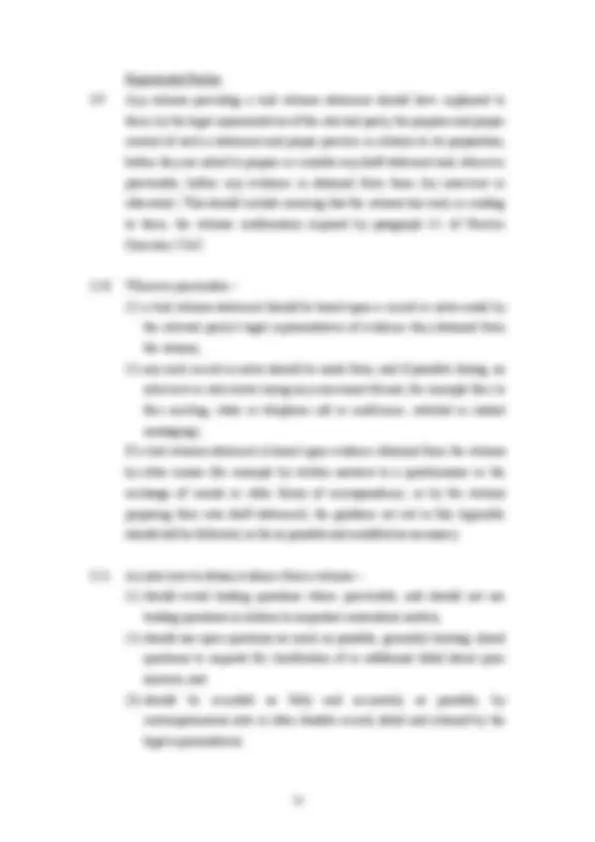
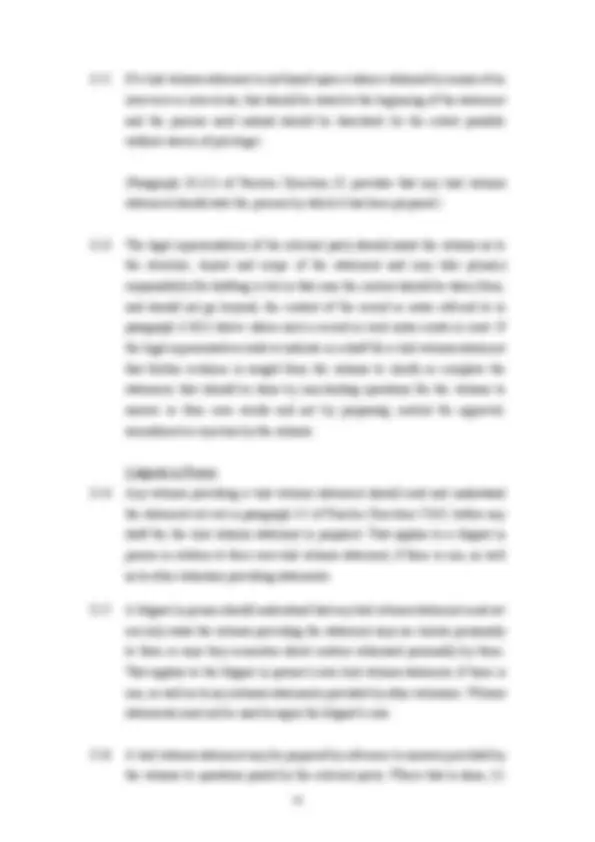
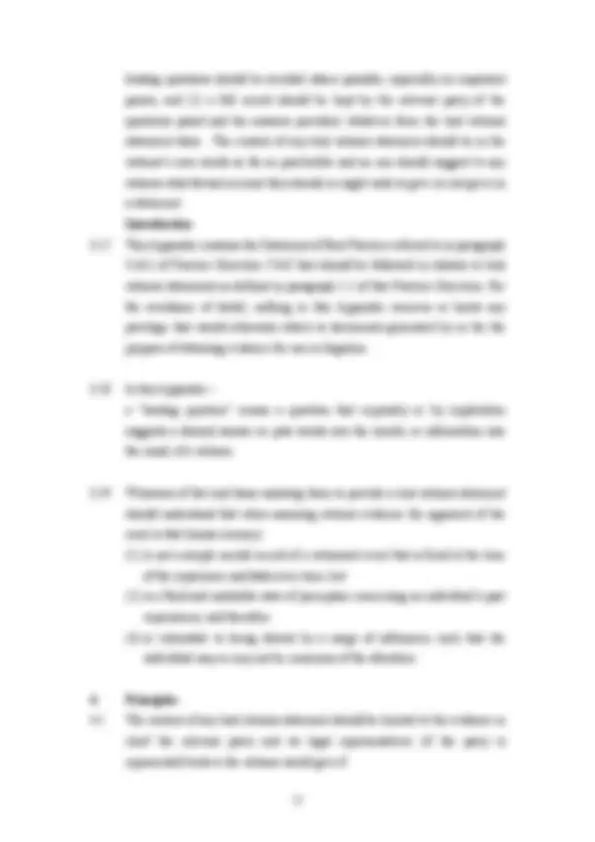
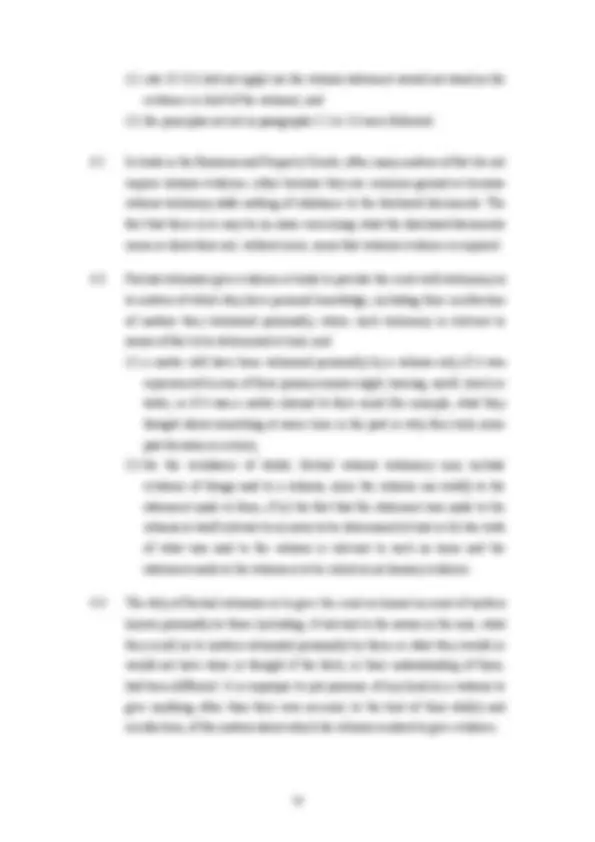
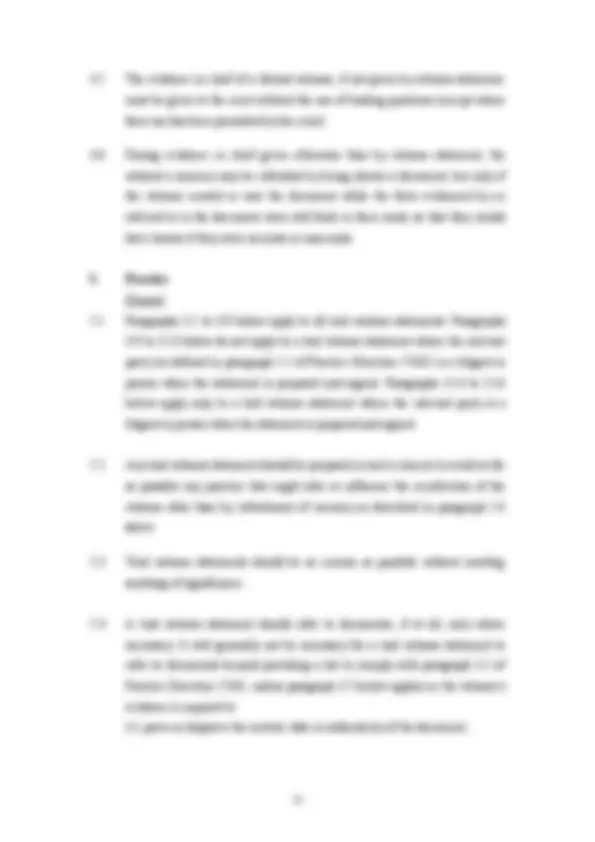
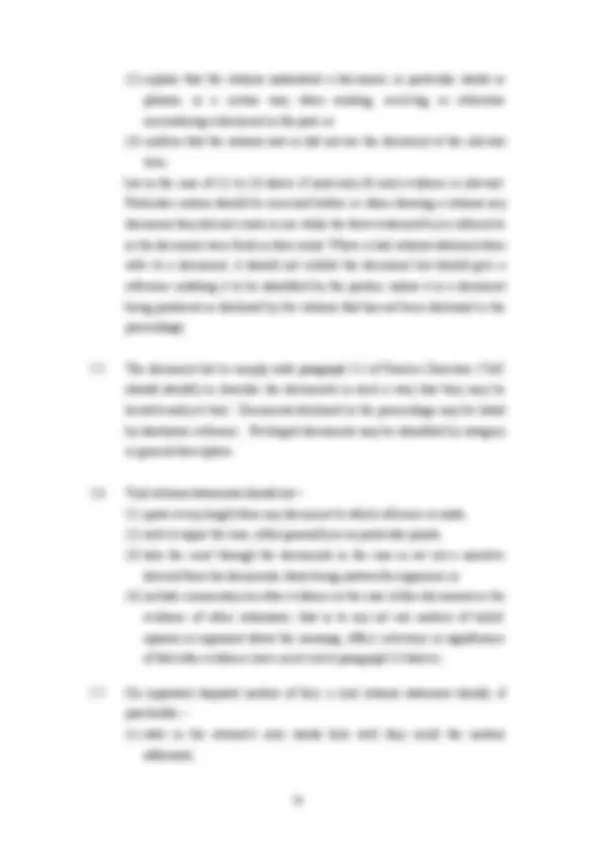
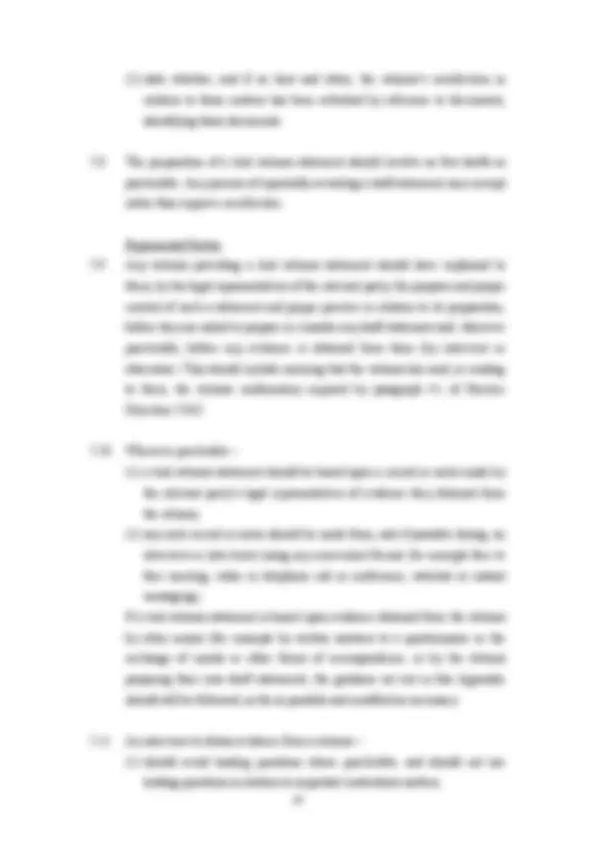
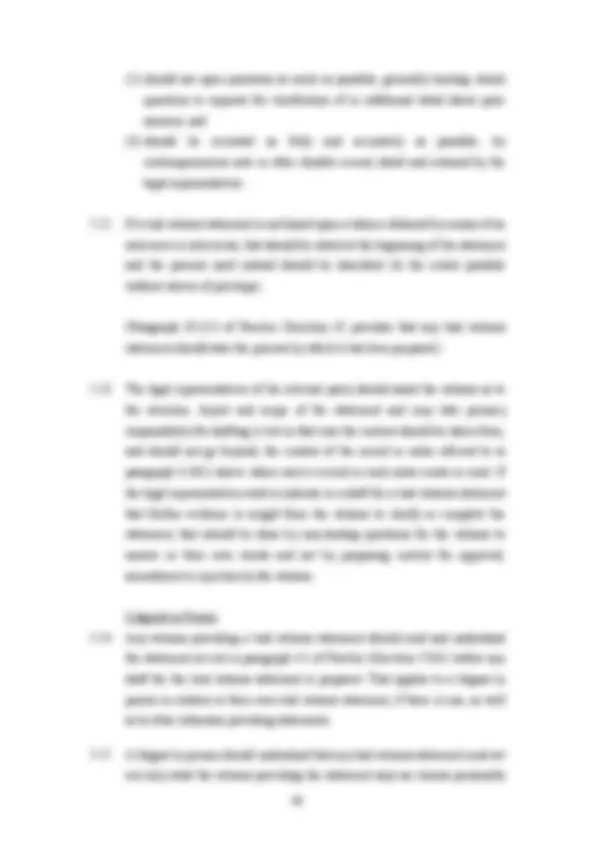
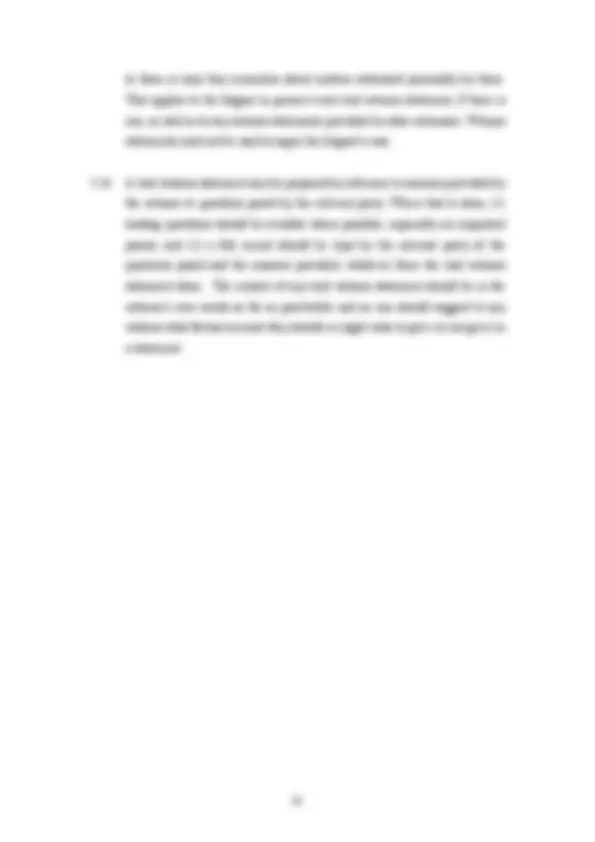
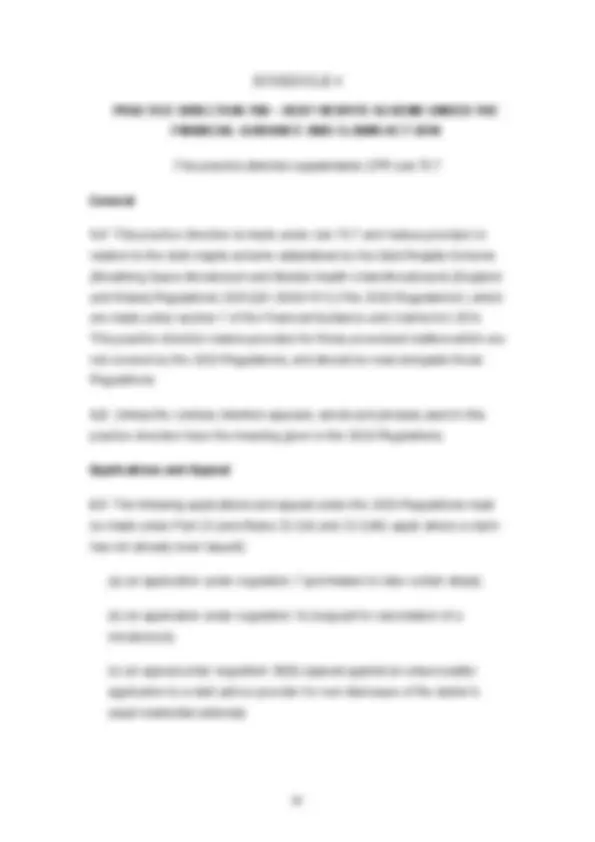
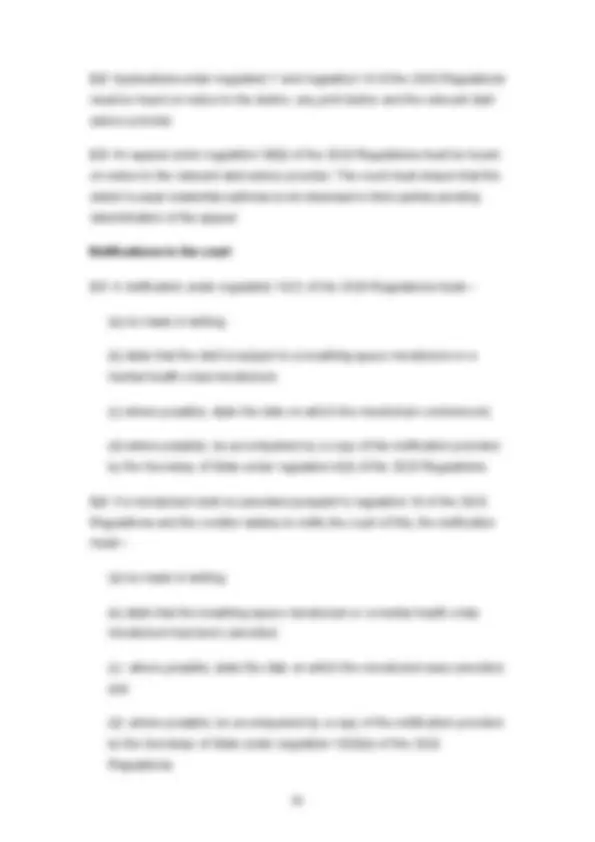



Study with the several resources on Docsity

Earn points by helping other students or get them with a premium plan


Prepare for your exams
Study with the several resources on Docsity

Earn points to download
Earn points by helping other students or get them with a premium plan
Community
Ask the community for help and clear up your study doubts
Discover the best universities in your country according to Docsity users
Free resources
Download our free guides on studying techniques, anxiety management strategies, and thesis advice from Docsity tutors
The principles and procedures for disclosing documents in legal proceedings, including duties in relation to disclosure, preservation of documents, initial and extended disclosure, identifying issues for disclosure, and complying with orders for disclosure. It also covers confidentiality, redaction, and sanctions for non-compliance.
What you will learn
Typology: Schemes and Mind Maps
1 / 84

This page cannot be seen from the preview
Don't miss anything!













































































127th UPDATE – PRACTICE DIRECTION AMENDMENTS
The amendments to the Practice Directions supplementing the Civil Procedure Rules 1998 are
made by the Master of the Rolls under the powers delegated to him by the Lord Chief Justice
under Schedule 2, Part 1, paragraph 2(2) of the Constitutional Reform Act 2005, and is approved
by Chris Philp MP, Parliamentary Under-Secretary of State for Justice, by the authority of the Lord
Chancellor.
The amendments to the existing Practice Directions come into force as follows, subject to the transitional provision made in this update—
Amendment of 107th^ Update – Transitional Provision The day after the
day on which this Update is approved
Practice Direction 1A – Participation of Vulnerable Parties or
Witnesses
6 April 2021
Practice Direction 2E – Jurisdiction of the County Court That
May be Exercised by a Legal Adviser
6 April 2021
Practice Direction 2F – Court Sittings 6 April 2021
Practice Direction 3E – Costs Management 6 April 2021
Practice Direction 6B – Service out of the Jurisdiction 6 April 2021
Practice Direction 27 – Small Claims Track 6 April 2021
Practice Direction 45 – Fixed Costs 6 April 2021
Practice Direction 47 – Procedure for Assessment of Costs
and Default Provisions
6 April 2021
Practice Direction 51A – Transitional Arrangements 6 April 2021
Practice Direction 51O – Electronic Working Pilot Scheme 6 April 2021
Practice Direction 51U – Disclosure Pilot for the Business and
Property Courts
6 April 2021
Practice Direction 51X - New Statement of Costs for Summary
Assessment Pilot
30 March 2021
Practice Direction 55C – Coronavirus: Temporary Provision in
Relation to Possession Proceedings
The day after the day on which this
Update is approved
Practice Direction 57AC – Trial Witness Statements in the
Business and Property Courts
6 April 2021
Practice Direction 70 – Enforcement of Judgments and Orders 6 April 2021
Practice Direction 70B – Debt Respite Scheme Under the
Financial Guidance and Claims Act 2018
6 April 2021
Practice Direction 71 – Orders to Obtain Information from
Judgment Debtors
6 April 2021
Practice Direction – (CA: Admiralty Appeals: Assessors),
[1965] 1 W.L.R. 853 (1965)
6 April 2021
The Right Honourable Sir Geoffrey Vos
Master of the Rolls and Head of Civil Justice:
Signed by authority of the Lord Chancellor:
Chris Philp MP
Parliamentary Under-Secretary of State for Justice
Ministry of Justice
Date: 28th^ January 2021
TRANSITIONAL PROVISION
Practice Direction 71 – Orders to Obtain Information from Judgment Debtors do not apply to applications— i) in relation to contempt of court; or ii) in relation to a writ of sequestration,
that are made before 6 April 2021.
In paragraph 10(a), for “interlocutory” substitute “interim”.
In the table below paragraph 10, in the section for “Disclosure”, in the second bullet in the final
column, for “third party” substitute “non-party”.
PRACTICE DIRECTION 6B – SERVICE OUT OF THE JURISDICTION
a) at the end of sub-paragraph (b) insert “or”; b) at the end of sub-paragraph (b), for “; or” substitute a full stop; and c) omit sub-paragraph (d).
PRACTICE DIRECTION 27 – SMALL CLAIMS TRACK
earnings) and (f)”.
PRACTICE DIRECTION 45 – FIXED COSTS
PRACTICE DIRECTION 47 – PROCEDURE FOR ASSESSMENT OF COSTS AND DEFAULT
PROVISIONS
“ 19. Where an offer to settle is made, whether under Part 36 or otherwise, it should specify whether or not it is intended to be inclusive of the cost of preparation of the bill and VAT. An offer which is made otherwise than under Part 36 should specify whether or not it is intended to be inclusive of interest. Unless the offer states otherwise it will be treated as being inclusive of all of these.
(A Part 36 offer is treated as inclusive of interest: see CPR 36.5(4).)”
PRACTICE DIRECTION 51A – TRANSITIONAL ARRANGEMENTS
PRACTICE DIRECTION 51O – ELECTRONIC WORKING PILOT SCHEME
PRACTICE DIRECTION 51U – DISCLOSURE PILOT FOR THE BUSINESS AND PROPERTY
COURTS
substitute the amended Practice Direction 51U, Appendix 1, Appendix 2 and Explanatory Notes to Appendix 2 as set out in Schedule 2 to this Update.
PRACTICE DIRECTION 51X – NEW STATEMENT OF COSTS FOR SUMMARY ASSESSMENT
PILOT
PRACTICE DIRECTION 55C – CORONAVIRUS: TEMPORARY PROVISION IN RELATION TO
POSSESSION PROCEEDINGS
In paragraph 1.1, for “28 March 2021” substitute “30 July 2021”.
In paragraph 2.6, for “29 January 2021” substitute “30 April 2021”.
In paragraph 5.3, for “29 January 2021” substitute “30 April 2021”.
”.
“ Suspended order punishing a person for non-compliance- rules 71.8(2) and (3)(a)
7.1 An order punishing a person for non-compliance with an order to attend court will be
suspended provided the person subsequently attends as required by that order, either before a
judge or, if the judge making the suspended order so directs, before a court officer.
7.2 Rule 71.3 and paragraph 3 of this practice direction (service of order) and rule 71.5(1)(a) and
(2) (affidavit of service), apply with the necessary changes to such an order.”.
“ Breach of terms on which order is suspended – rule 71.8(3)(b)
8.1 If—
(1) the judgment debtor fails to attend court at the time and place specified in a suspended order punishing them for non-compliance; and
(2) it appears to the judge or court officer that the judgment debtor has been duly served with the order,
the judge or court officer will certify in writing the debtor’s failure to attend.
8.2 If the judgment debtor fails to comply with any other term on which the order was suspended,
the judge or court officer will certify in writing the non-compliance and set out details of it.
8.3 A warrant to bring the judgment debtor before a judge may be issued on the basis of a
certificate under paragraph 8.1 or 8.2.
8.4 The hearing under rule 71.8(3)(b) may take place before a Master or District Judge.
8.5 At the hearing the judge will discharge the order imposing punishment unless satisfied beyond
reasonable doubt that—
(1) the judgment debtor has failed to comply with—
(a) the original order to attend court; and
(b) the terms on which the order imposing punishment was suspended; and
(2) both orders have been duly served on the judgment debtor.
8.6 If the judge decides that the order imposing punishment should not be discharged, it will be
enforceable immediately. Rules 81.9 and 81.10 make provision for enforcement of orders
punishing a person for contempt of court.”.
PRACTICE DIRECTION – (CA: ADMIRALTY APPEALS: ASSESSORS) [1965] 1 W.L.R. 853
(1965)
revoked.
5. When considering whether a factor may adversely affect the ability of a party or
witness to participate in proceedings and/or give evidence, the court should consider
their ability to—
(a) understand the proceedings and their role in them;
(b) express themselves throughout the proceedings;
(c) put their evidence before the court;
(d) respond to or comply with any request of the court, or do so in a timely manner;
(e) instruct their representative/s (if any) before, during and after the hearing; and
(f) attend any hearing.
6. The Court, with the assistance of the parties, should try to identify vulnerability of
parties or witnesses at the earliest possible stage of proceedings and to consider
whether a party’s participation in the proceedings, or the quality of evidence given by a
party or witness, is likely to be diminished by reason of vulnerability and, if so, whether
it is necessary to make directions as a result.
7. If the court decides that a party’s or witness’s ability to participate fully and/or give
best evidence is likely to be diminished by reason of vulnerability, the court may
identify the nature of the vulnerability in an order and may order appropriate provisions
to be made to further the overriding objective.
8. Subject to the nature of any vulnerability having been identified and appropriate
provisions having been made, the court should consider ordering “ground rules” before
a vulnerable witness is to give evidence, to determine what directions are necessary in
relation to the nature and extent of that evidence, the conduct of the advocates and/or
the parties in respect of the evidence of that person, and/or any necessary support to
be put in place for that person.
Title Paragraph number
General PARA.
SECTION I
Principles, “documents”, “adverse” and “known adverse documents”
PARA.
Duties in relation to disclosure PARA.
Preservation of documents PARA.
Initial Disclosure PARA.
Extended Disclosure PARA.
Identifying the Issues for Disclosure PARA.
The Extended Disclosure Models PARA.
Other provisions concerning Disclosure Models PARA.
Completion of the Disclosure Review Document PARA.
Disclosure Guidance Hearings PARA.
Complying with an order for Extended Disclosure PARA.
Production of documents PARA.
Right to withhold production of documents (other than public interest immunity)
PARA.
Confidentiality PARA.
Redaction PARA.
Failure adequately to comply with an order for Extended Disclosure
PARA.
Varying an order for Extended Disclosure; making an additional order for disclosure of specific documents
PARA.
Restriction on use of a privileged document which has been inadvertently produced
PARA.
Sanctions PARA.
Documents referred to in evidence PARA.
Cost PARA.
False Disclosure Certificates PARA.
(4) within the Admiralty Court;
(5) within the Shorter and Flexible Trials Schemes; or
(6) within a fixed costs regime or a capped costs regime.
1.5 In the Patents Court, PD63 paragraphs 6.1 to 6.3 will continue to apply under the pilot with the following modification: unless the court expressly orders otherwise, no provision in this practice direction nor any disclosure order made under this pilot will take effect as requiring disclosure wider than is provided for in PD 63 paragraph 6.1.
1.6 The pilot will continue to apply after the end of the three year period to any proceedings to which it applied at that point.
1.7 For the purposes of the pilot, where the provisions of this Practice Direction conflict with other provisions of the rules or other Practice Directions, this Practice Direction shall take precedence.
1.8 Terms in Section I of this Practice Direction shall have the meaning given to them in the schedule of definitions at Appendix 1.
1.9 Save for those provisions of CPR Part 31 that are set out in Section II, and the related provisions of Practice Directions 31A and 31B, CPR Part 31 and Practice Directions 31A and 31B shall not apply to any proceedings falling within the pilot.
1.10 Save that references in Section II to an Electronic Documents Questionnaire should be treated as references to the Disclosure Review Document, nothing in this Practice Direction is intended to change the application or working of those provisions of CPR Part 31 that are set out in Section II and the related provisions of Practice Directions 31A and 31B, and CPR Part 31 as a whole should still be used to interpret those provisions.
2.1 Disclosure is important in achieving the fair resolution of civil proceedings. It involves identifying and making available documents that are relevant to the issues in the proceedings.
2.2 For the purpose of disclosure, the term “document” includes any record of any description containing information. The term is further defined below.
2.3 The court expects the parties (and their representatives) to cooperate with each other and to assist the court so that the scope of disclosure, if any, that is required in proceedings can be agreed or determined by the court in the most efficient way possible.
2.4 The court will be concerned to ensure that disclosure is directed to the issues in the proceedings and that the scope of disclosure is not wider than is reasonable and proportionate (as defined in paragraph 6.4) in order fairly to resolve those issues, and specifically the Issues for Disclosure (as defined in paragraph 7.3).
2.5 A “document” may take any form including but not limited to paper or electronic; it may be held by computer or on portable devices such as memory sticks or mobile phones or within databases; it includes e-mail and other electronic communications such as text messages, webmail, social media and voicemail, audio or visual recordings.
2.6 In addition to information that is readily accessible from computer systems and other electronic devices and media, the term “document” extends to information that is stored on servers and back- up systems and electronic information that has been ‘deleted’. It also extends to metadata, and other embedded data which is not typically visible on screen or a print out.
2.7 Disclosure extends to “adverse” documents. A document is “adverse” if it or any information it contains contradicts or materially damages the disclosing party’s contention or version of events on an issue in dispute, or supports the contention or version of events of an opposing party on an issue in dispute.
2.8 “Known adverse documents” are documents (other than privileged documents) that a party is actually aware (without undertaking any further search for documents than it has already undertaken or caused to be undertaken) both (a) are or were previously within its control and (b) are adverse.
2.9 For this purpose a company or organisation is “aware” if any person with accountability or responsibility within the company or organisation for the events or the circumstances which are the subject of the case, or for the conduct of the proceedings, is aware. For this purpose it is also necessary to take reasonable steps to check the position with any person who has had such accountability or responsibility but who has since left the company or organisation.
3.1 A person who knows that it is or may become a party to proceedings that have been commenced or who knows that it may become a party to proceedings that may be commenced is under the following duties (“the Disclosure Duties”) to the court—
(1) to take reasonable steps to preserve documents in its control that may be relevant to any issue in the proceedings;
(2) once proceedings have commenced against it or by it , to disclose, regardless of any order for disclosure made, known adverse documents, unless they are privileged. The latest time(s) for disclosing known adverse documents are those set out in paragraphs 9.1 to 9.3);
(3) to comply with any order for disclosure made by the court;
(4) to undertake any search for documents in a responsible and conscientious manner to fulfil the stated purpose of the search;
(5) to act honestly in relation to the process of giving disclosure and reviewing documents disclosed by the other party; and
(3) an obligation to take reasonable steps so that agents or third parties who may hold documents on the party’s behalf do not delete or destroy documents that may be relevant to an issue in the proceedings.
4.3 A written notification under paragraph 4.2 above should—
(1) identify the documents or classes of documents to be preserved; and
(2) notify the recipient that they should not delete or destroy those documents and should take reasonable steps to preserve them.
4.4 Legal representatives who have the conduct of litigation on behalf of a party to proceedings that have been commenced, or who are instructed with a view to the conduct of litigation where their client knows it may become a party to proceedings that have been or may be commenced, must within a reasonable period of being instructed—
(1) notify their client of the need to preserve documents and of their obligations under paragraph 3.1 above; and
(2) obtain written confirmation from their client or an appropriate representative of their client that their client has taken the steps required under paragraphs 4.2 and 4.3 above.
4.5 Each party must confirm in writing (and may do so by their legal representative) when serving their particulars of claim or defence (as appropriate), that steps have been taken to preserve relevant documents in accordance with the duties under paragraph 3.1(1) and 3.2(1) above, and as required by paragraph 4.1 to 4.4 above.
5.1 Save as provided below, and save in the case of a Part 7 claim form without particulars of claim or a Part 8 claim form, each party must provide to all other parties at the same time as its statement of case an Initial Disclosure List of Documents that lists and is accompanied by copies of—
(1) the key documents on which it has relied (expressly or otherwise) in support of the claims or defences advanced in its statement of case (and including the documents referred to in that statement of case); and
(2) the key documents that are necessary to enable the other parties to understand the claim or defence they have to meet.
5.2 This form of disclosure is known as “Initial Disclosure”.
5.3 Initial Disclosure is not required where—
(1) the parties have agreed to dispense with it (see paragraph 5.8 below);
(2) the court has ordered that it is not required (see paragraph 5.10 below); or
(3) a party concludes and states in writing, approaching the matter in good faith, that giving Initial Disclosure would involve it or any other party providing (after removing duplicates, and including documents referred to at paragraph 5.4(3)(a)) more than (about) whichever is the larger of 1000 pages or 200 documents (or such higher but reasonable figure as the parties may agree), at which point the requirement to give Initial Disclosure ceases for all parties for the purposes of the case.
Documents comprising media not in page form are not included in the calculation of the page or document limit at (3) but, where provided pursuant to a requirement to give Initial Disclosure, should be confined strictly to what is necessary to comply with paragraph 5.1 above.
5.4 A party giving Initial Disclosure—
(1) is under no obligation to undertake a search for documents beyond any search it has already undertaken or caused to be undertaken for the purposes of the proceedings (including in advance of the commencement of the proceedings);
(2) should briefly describe in its Initial Disclosure List of Documents any searches just mentioned;
(3) need not provide unless requested documents by way of Initial Disclosure if such documents—
(a) have already been provided to the other party, whether by disclosure before proceedings start (see CPR 31.16) or through pre-action correspondence or otherwise in the period following intimation of the proceedings (and including when giving Initial Disclosure with a statement of case that is being amended); or
(b) are known to be or have been in the other party’s possession;
(4) need not disclose adverse documents.
5.5 Unless otherwise ordered, or agreed between the parties, copies of documents shall be provided in electronic form for the purpose of Initial Disclosure. The Initial Disclosure List of Documents should be filed but the documents must not be filed.
5.6 In proceedings where a statement of case is to be served on a defendant out of the jurisdiction Initial Disclosure is not required in respect of that defendant unless and until that defendant files an acknowledgement of service that does not contest the jurisdiction, or files a further acknowledgement of service under CPR 11(7)(b).
5.7 For the avoidance of doubt, Initial Disclosure does not require any document to be translated.
5.8 The parties may agree in writing, before or after the commencement of proceedings, to dispense with, or defer, Initial Disclosure. They may also agree to dispense with the requirement to produce an Initial Disclosure List of Documents. Each party should record its respective reasons for any agreement, so that those reasons may be available to the court, on request, at any case management conference. The court may set aside an agreement to dispense with or defer Initial Disclosure if it considers that Initial Disclosure is likely to provide significant benefits and the costs of providing Initial Disclosure are unlikely to be disproportionate to such benefits.
5.9 The court shall disregard any prior agreement to dispense with Initial Disclosure when considering whether to order Extended Disclosure.
(3) the likelihood of documents existing that will have probative value in supporting or undermining a party’s claim or defence;
(4) the number of documents involved;
(5) the ease and expense of searching for and retrieval of any particular document (taking into account any limitations on the information available and on the likely accuracy of any costs estimates);
(6) the financial position of each party; and
(7) the need to ensure the case is dealt with expeditiously, fairly and at a proportionate cost.
6.5 A request for search-based Extended Disclosure (ie Models C, D and/or E) must specify which of the Disclosure Models listed in paragraph 8 below is proposed for each Issue for Disclosure defined in paragraph 7 below. It is for the party requesting Extended Disclosure to show that what is sought is appropriate, reasonable and proportionate (as defined in paragraph 6.4). Where Disclosure Model D or E is proposed parties should be ready to explain to the court why Disclosure Model C is not sufficient.
6.6 The objective of relating Disclosure Models to Issues for Disclosure is to limit the searches required and the volume of documents to be disclosed. Issues for Disclosure may be grouped. Disclosure Models should not be used in a way that increases cost through undue complexity.
7.1 Within 28 days of the final statement of case each party should state, in writing, whether or not it is likely to request search-based Extended Disclosure to include one or more of Models C, D or E (see paragraph 8 below) on one or more issues in the case. At this point it should not particularise the Model(s) or the issue(s) in the case.
7.2 Where one or more of the parties has indicated it is likely to request search-based Extended Disclosure (i.e. Models C, D and/or E), the claimant must within 42 days of the final statement of case, prepare and serve on the other parties a draft List of Issues for Disclosure unless the equivalent of such a list has already been agreed between the parties (for example, as part of a fuller list of issues). A List of Issues for Disclosure is not required if the parties are agreed that Extended Disclosure is to be confined to Models A and B. The List of Issues for Disclosure should be set out using Section 1A of the Disclosure Review Document (see further paragraph 10 below).
7.3 “Issues for Disclosure” means for the purposes of disclosure only those key issues in dispute, which the parties consider will need to be determined by the court with some reference to contemporaneous documents in order for there to be a fair resolution of the proceedings. It does not extend to every issue which is disputed in the statements of case by denial or non-admission.
7.4 The claimant should seek to ensure that the draft List of Issues for Disclosure provides a fair and balanced summary of the key areas of dispute identified by the parties’ statements of case and in respect of which it is likely that one or other of the parties will be seeking search-based Extended Disclosure.
7.5 In the event that a particular Issue for Disclosure has not been included in the List of Issues for Disclosure, or is described in a manner that is unacceptable to the defendant, using Section 1A of the Disclosure Review Document the defendant should provide the claimant with its proposed wording or alternative wording for inclusion in the draft List of Issues for Disclosure as soon as practicable but in any event no later than 14 days after service of the draft List of Issues for Disclosure.
7.6 In advance of the first case management conference, the parties must discuss and seek to agree the draft List of Issues for Disclosure. They should consider whether any draft Issue for Disclosure can be removed. For each Issue for Disclosure that is maintained, the parties should indicate at this point, using Section 1A of the Disclosure Review Document, which Model of Extended Disclosure is sought for each party. Where Model C Disclosure is contemplated the parties should discuss the requests that might apply for the purpose of that disclosure (see further paragraph 10.4 below).
7.7 The List of Issues for Disclosure may be revised or supplemented at any time prior to or following the case management conference, including as a result of statements of case or amended statements of case subsequently served or discussions between the parties in relation to the Disclosure Review Document.
7.8 If the parties are (subject to the court) agreed that there are preliminary issues suitable for determination before other issues in the case, or that the case should be divided into stages, the parties may apply to the court before any case management conference for an order for the trial of those issues or for trial in stages (and related directions), and they may agree in writing to limit the work towards disclosure required by this Practice Direction until that application has been heard.
7.9 In an appropriate case where the claimant is acting in person and a defendant is not the court may request the legal representatives of the defendant to lead on the preparation of the List of Issues for Disclosure.
8.1 Extended Disclosure may take the form of one or more of the Disclosure Models set out below.
8.2 There is no presumption that a party is entitled to Extended Disclosure, and in particular to Model D or Model E disclosure. No Model will apply without the approval of the court.
8.3 The court may order that Extended Disclosure be given using different Disclosure Models for different Issues for Disclosure in the case. In the interests of avoiding undue complexity the court will rarely require different Models for the same set of documents. The court may also order that Extended Disclosure be given by only one party, or that different Models are to apply to each party’s Disclosure on a particular Issue for Disclosure.
Model A: Disclosure confined to known adverse documents
The court may order that the only disclosure required in relation to some or all of the Issues for Disclosure is of known adverse documents in accordance with the (continuing) duty under paragraph 3.1(2) above.